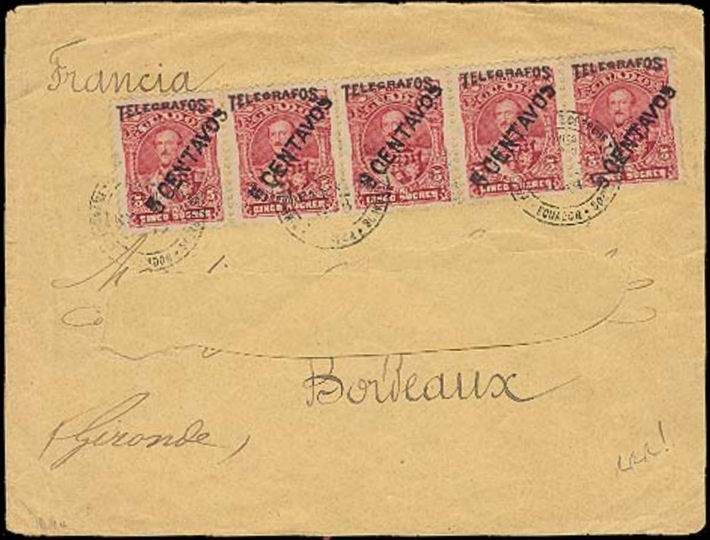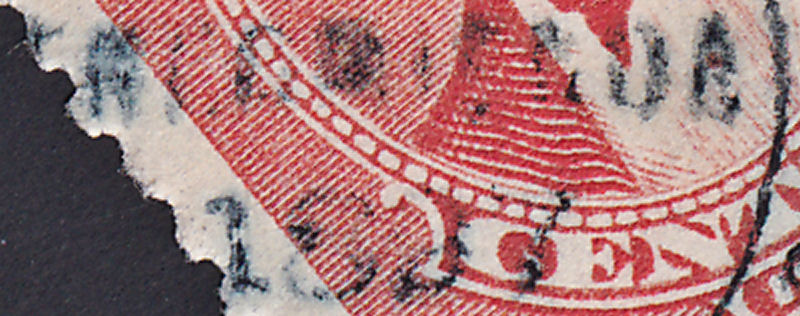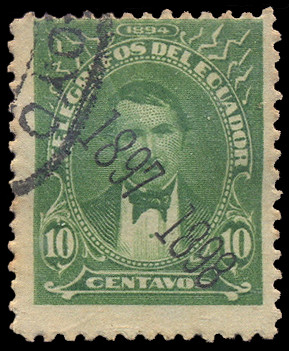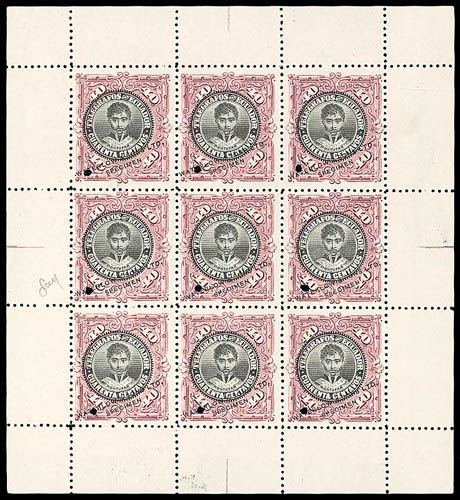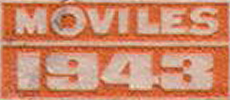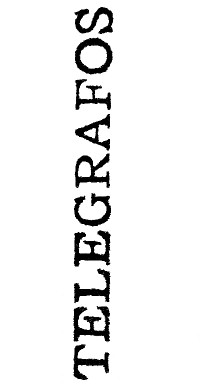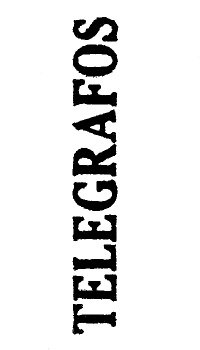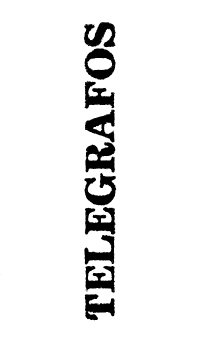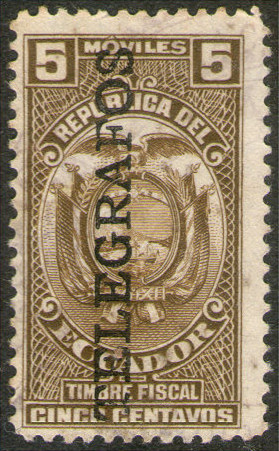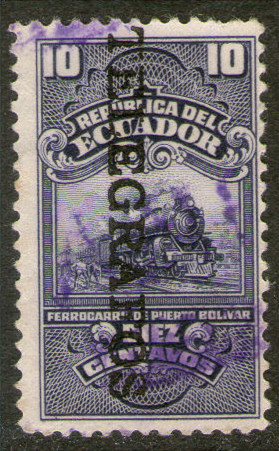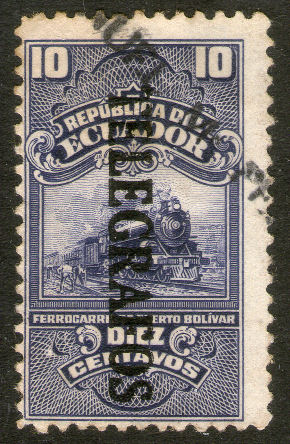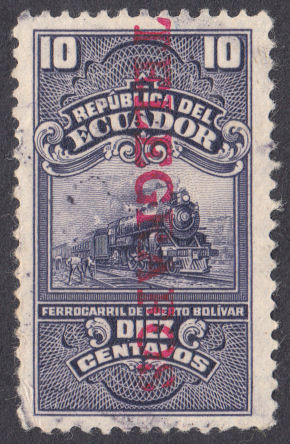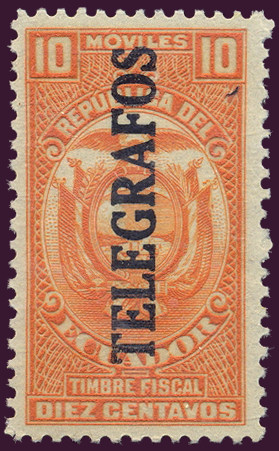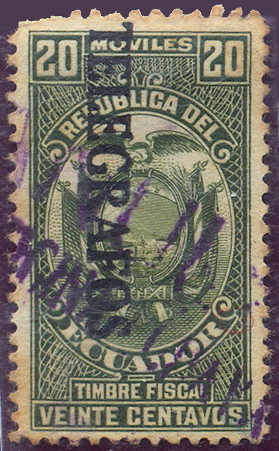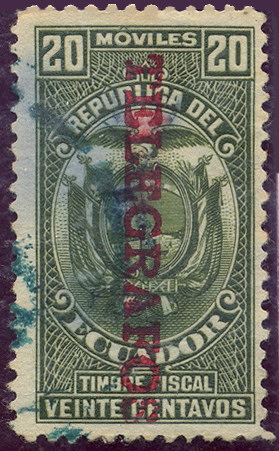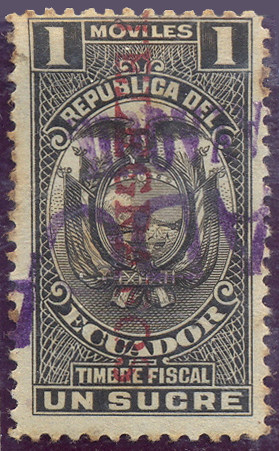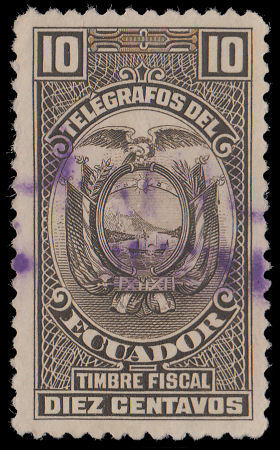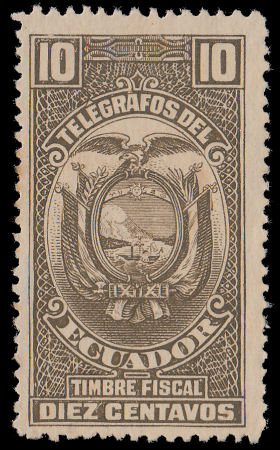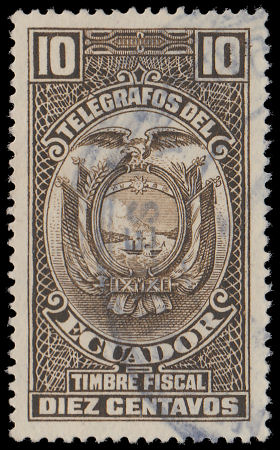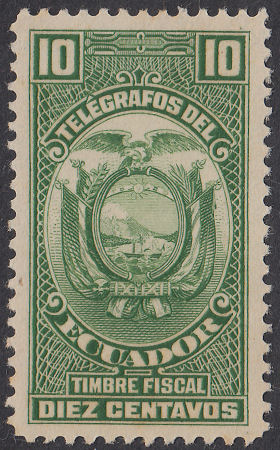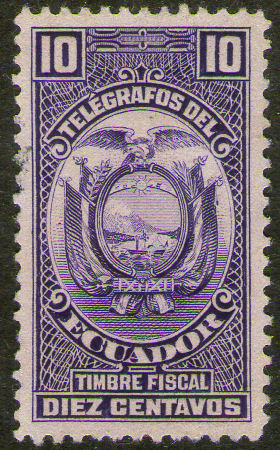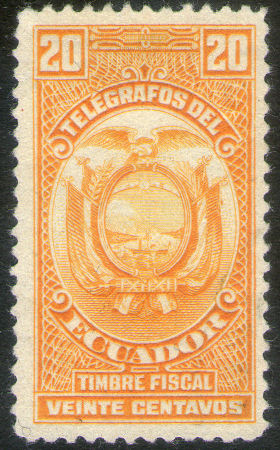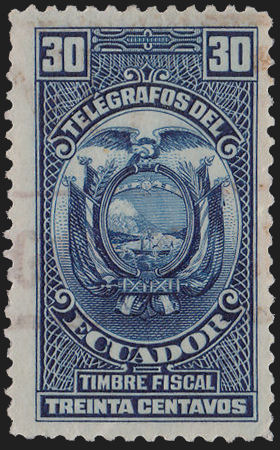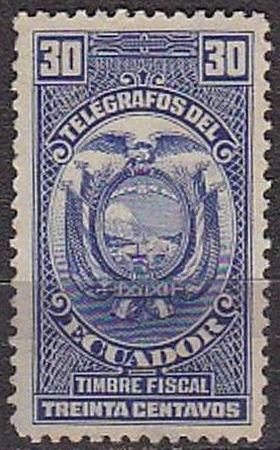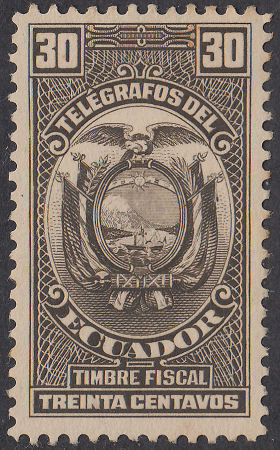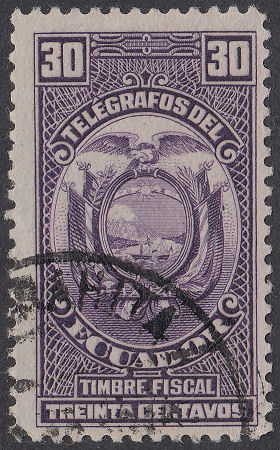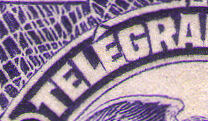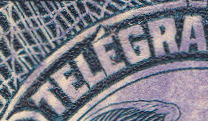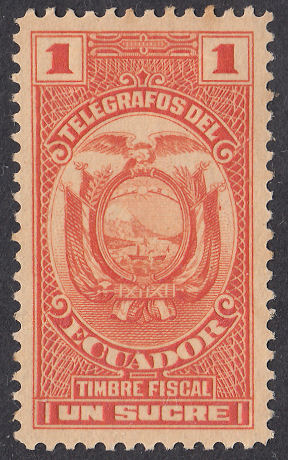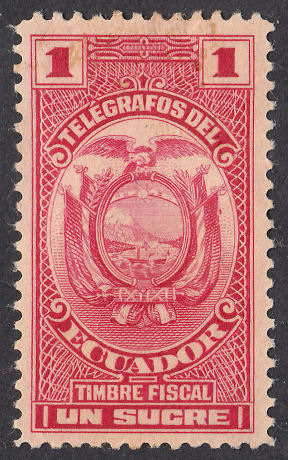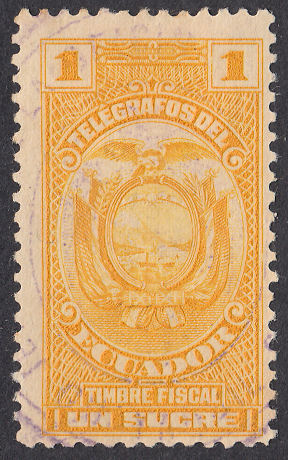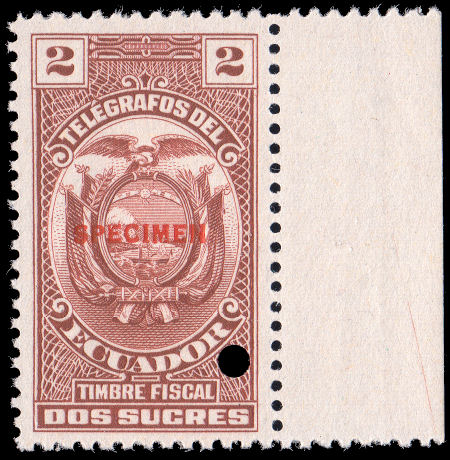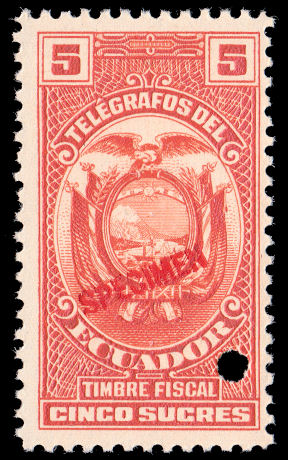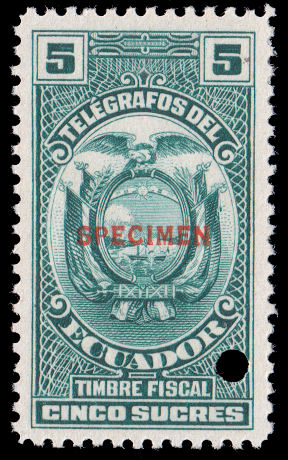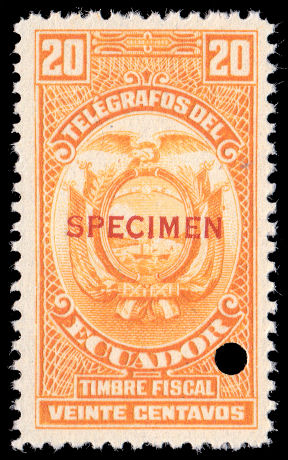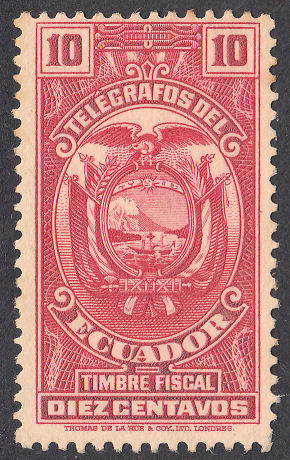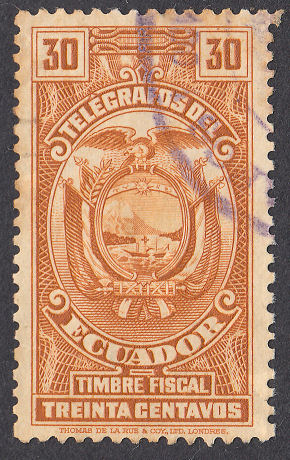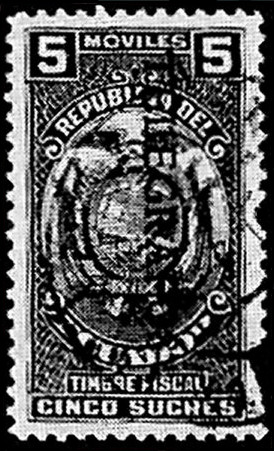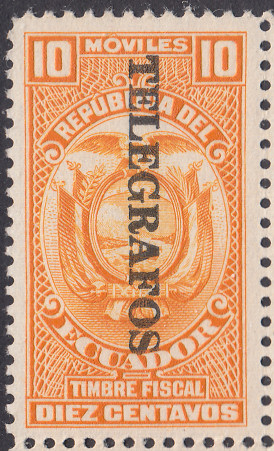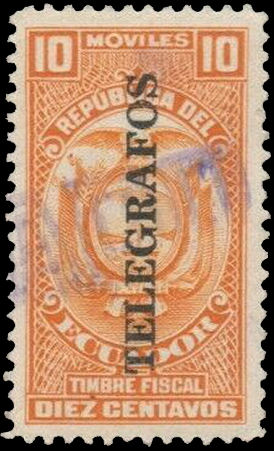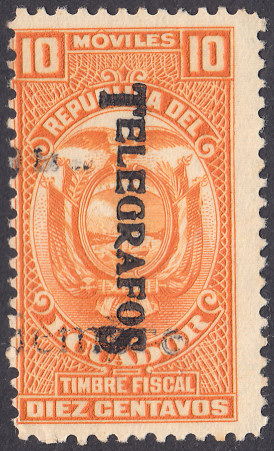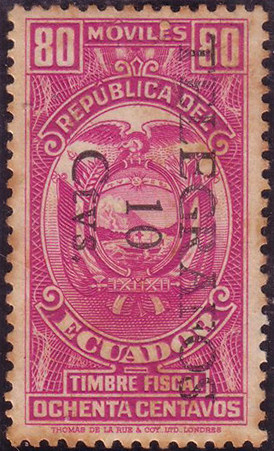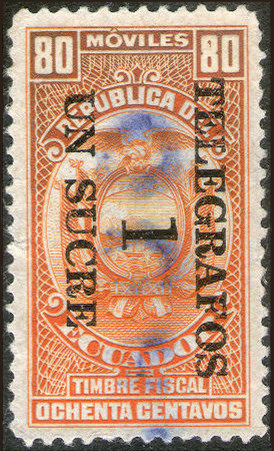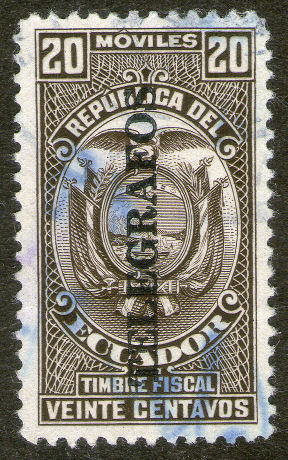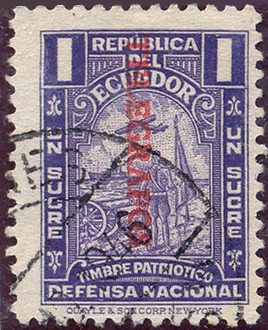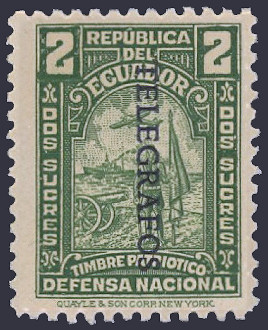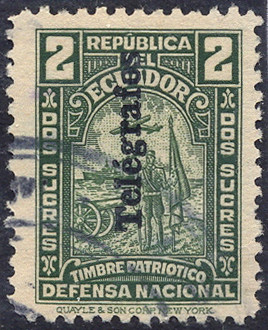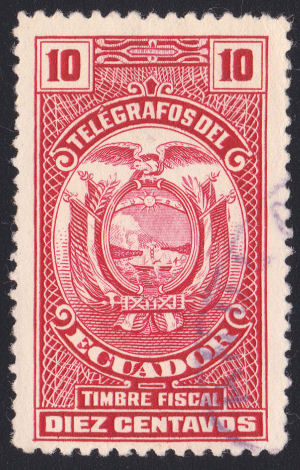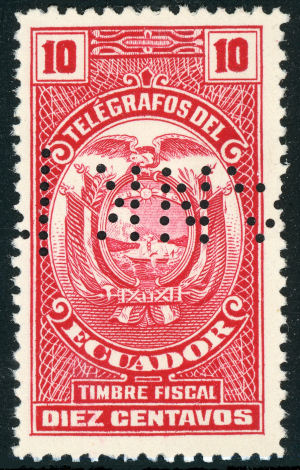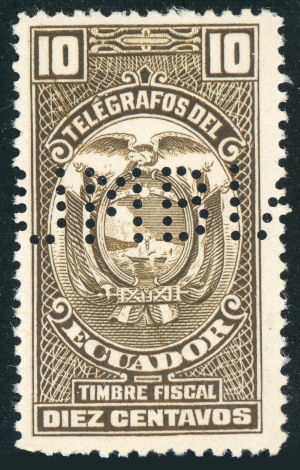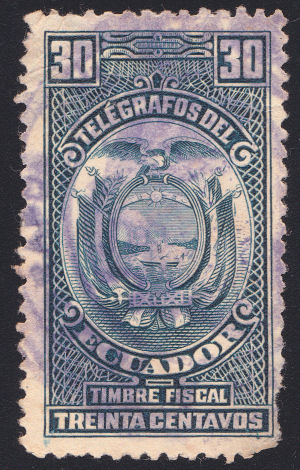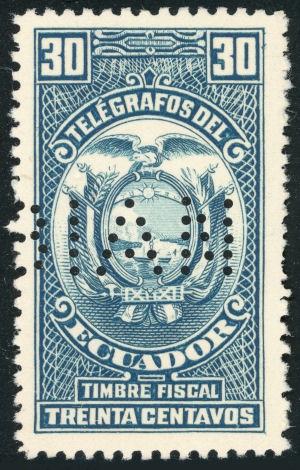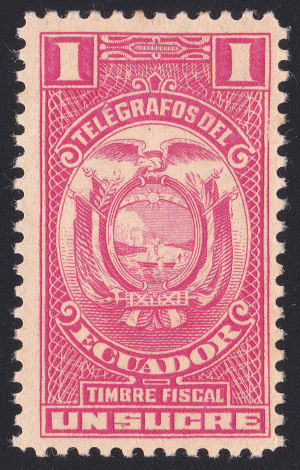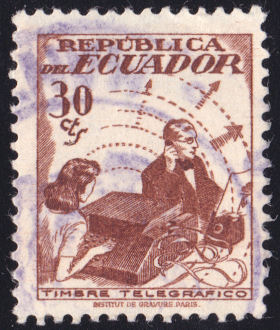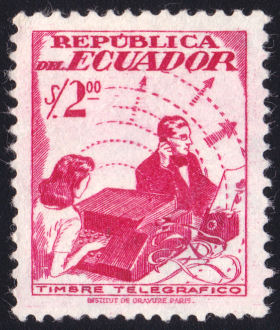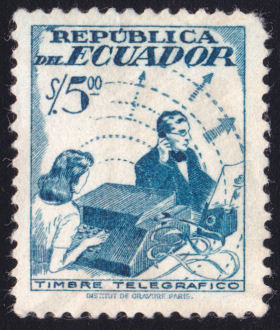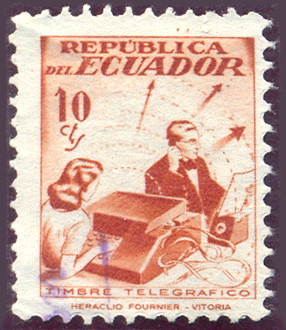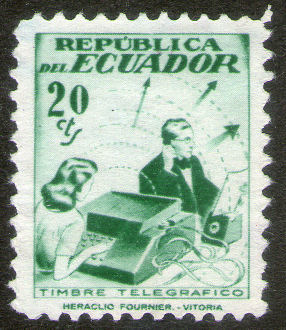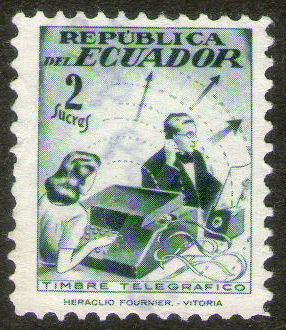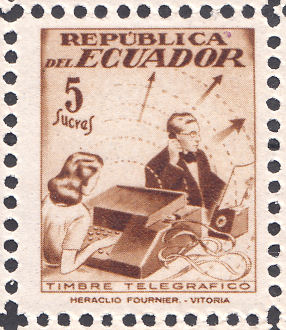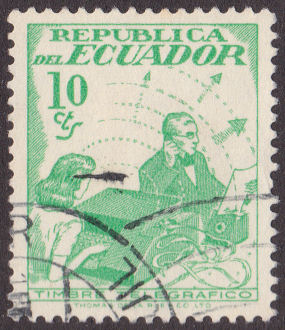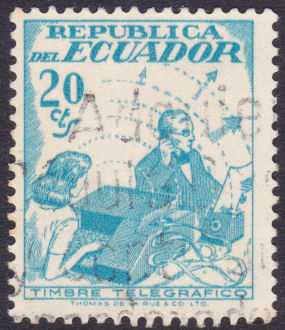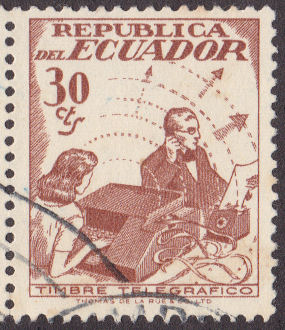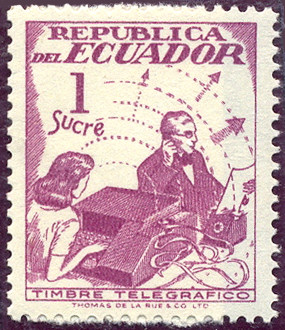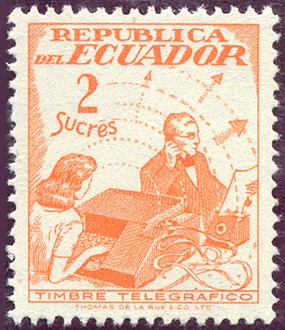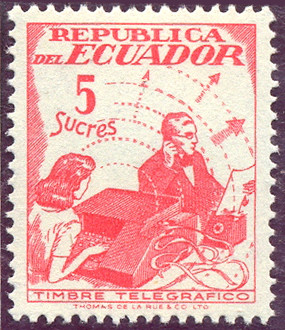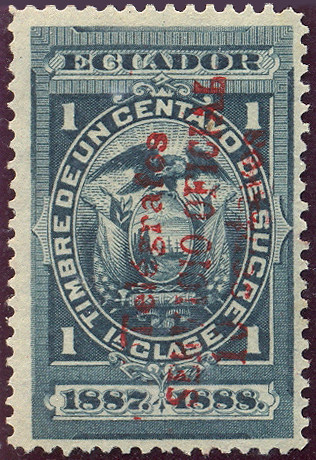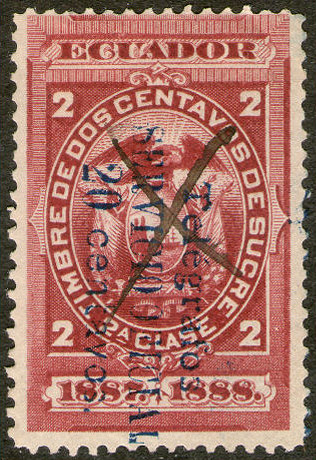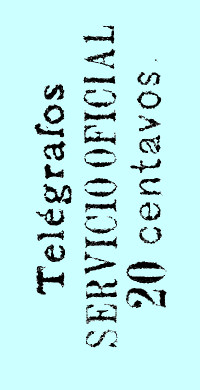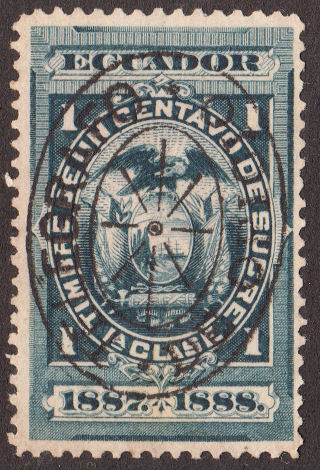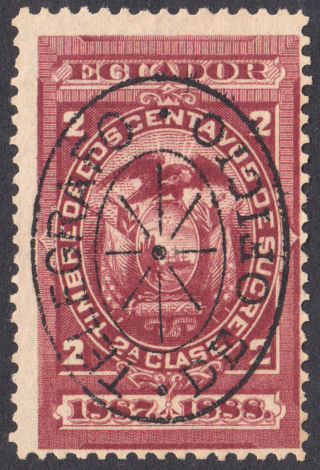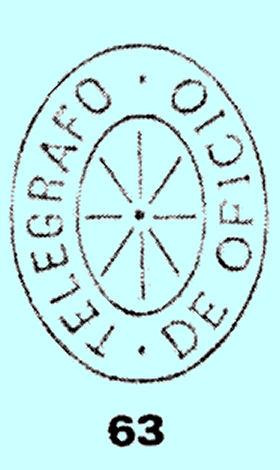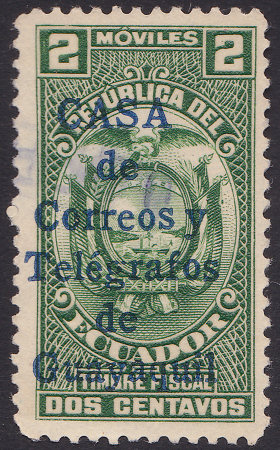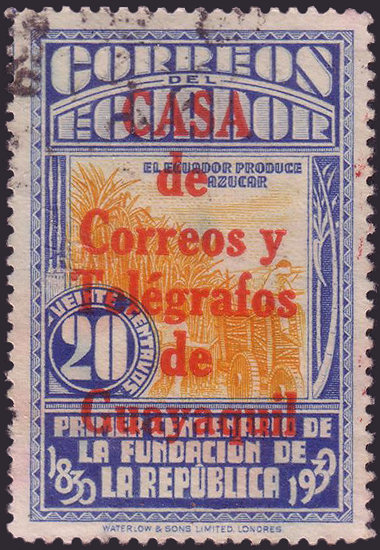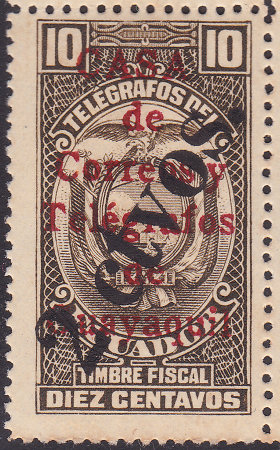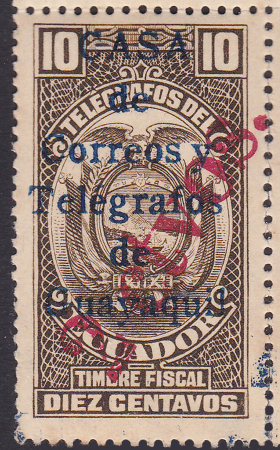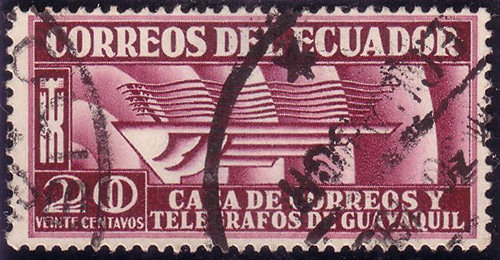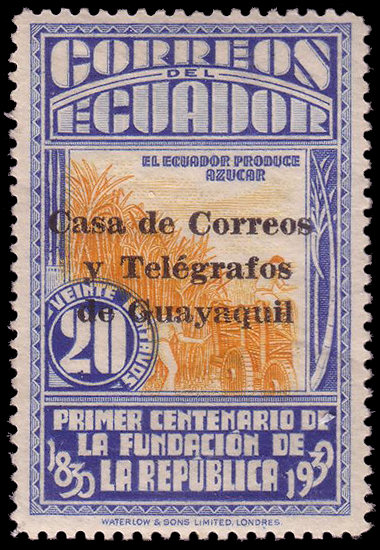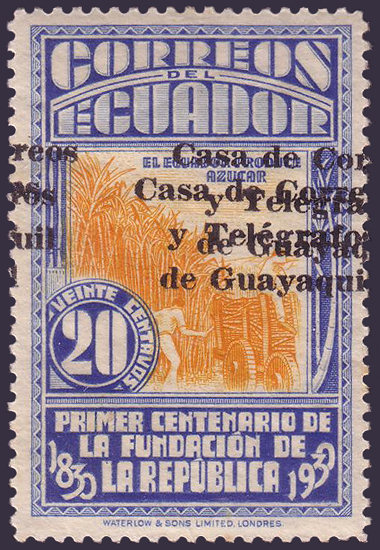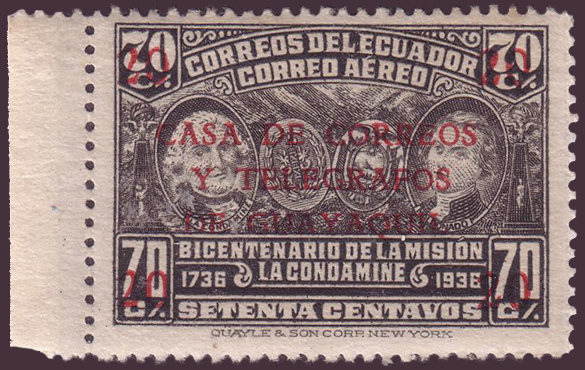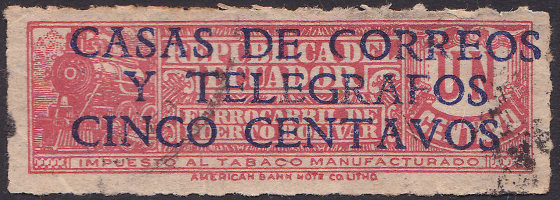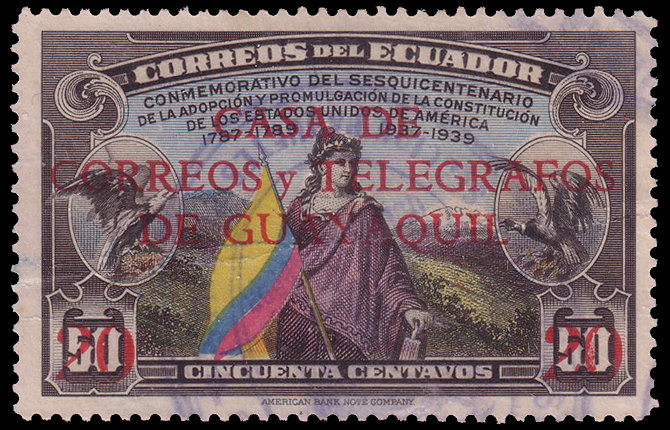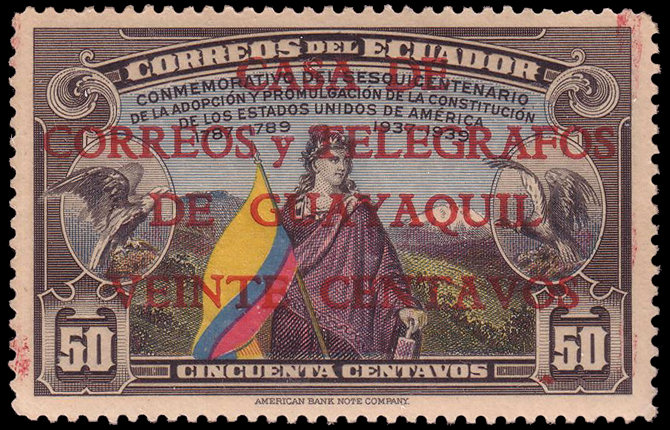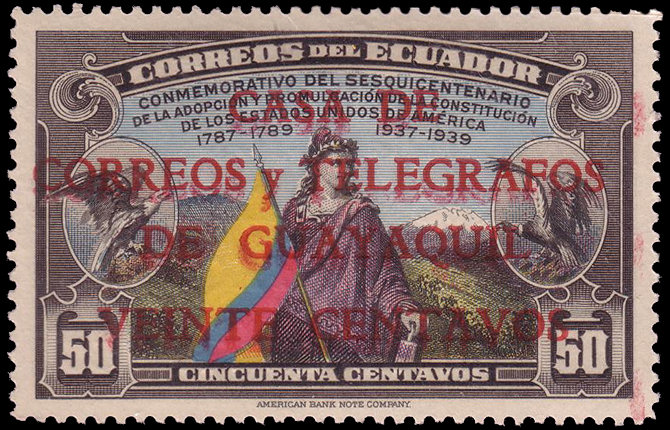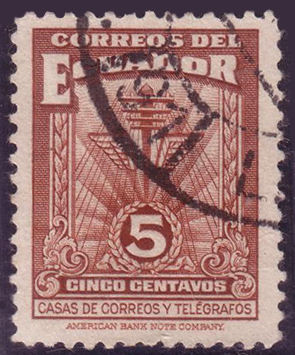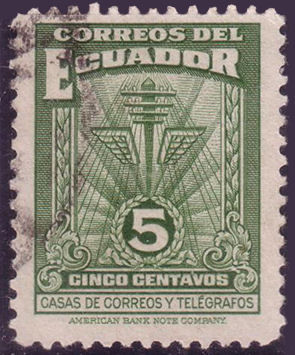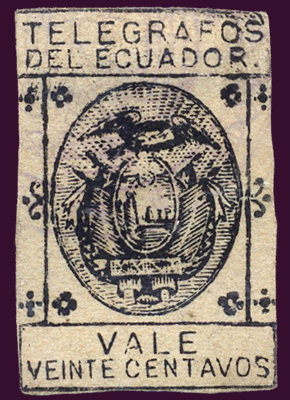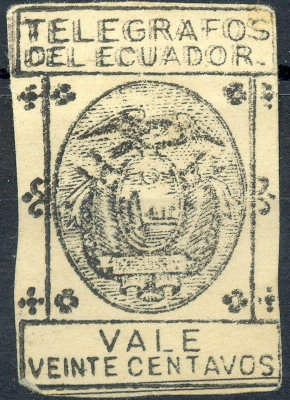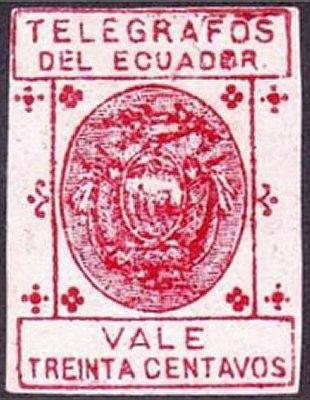| Up a level | ||||||||||
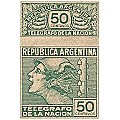 |
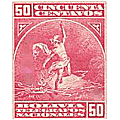 |
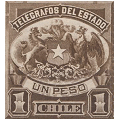 |
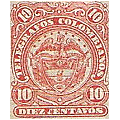 |
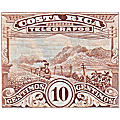 |
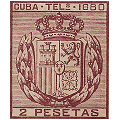 |
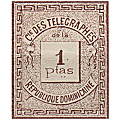 |
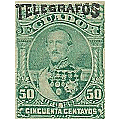 |
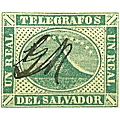 |
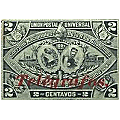 |
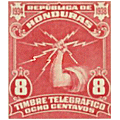 |
| Argentina | Bolivia | Chile | Colombia | Costa Rica | Cuba | Dominican Rep. | Ecuador | El Salvador | Guatemala | Honduras |
| Up a level | ||||||||||
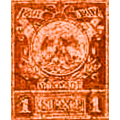 |
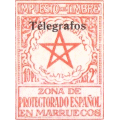 |
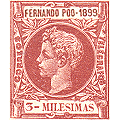 |
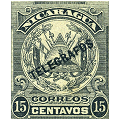 |
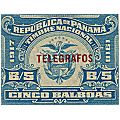 |
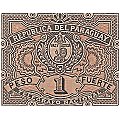 |
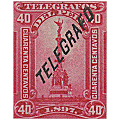 |
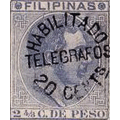 |
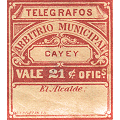 |
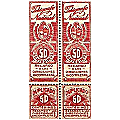 |
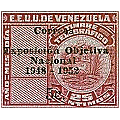 |
| Mexico | Morocco | Guinea | Nicaragua | Panama | Paraguay | Peru | Philippines | Puerto Rico | Uruguay | Venezuela |
Contributors: K. Zwart |
| Shortcuts to different sections | |||||||||||||
| Punch Cancels | 1894 | 1900 | 1919 | 1926 | 1928 | 1938 | 1940 | 1945 | 1950 | Officials | Tax Stamps | Prepaid Forms | Telegram Seals |
These are turning out to be much more complicated than earlier works would suggest. With a lot of help from others, the picture is gradually becoming clearer. I have revised Hiscocks' original listing, though leaving references to the original designations. I have added a few new items and removed the listing of centrally perforated items later found to be seals. These can now be found in the section on telegram seals. I have brought the prices up to date and added currency selection. The new designations have 'RH' numbers (Revised Hiscocks) to avoid confusion. CheckList Setup |
Ecuador.
Steve Hiscocks wrote:
The listing below is clearly incomplete since isolated telegraph stamps which appear to have been issued since 1945, the date of the last issue in
earlier catalogues, are met with from time to time. Attempts to obtain background information on the telegraph stamps of Ecuador and their use
and to find more complete information on later issues have so far, however, been unsuccessful.
A word should be said about the so called "Seebeck issues". N. F. Seebeck was a director of the Hamilton Bank Note Co. of New York, USA, who
obtained contracts from the Governments of Ecuador, El Salvador, Honduras, and Nicaragua to provide stamps (of all sorts) free on an annual basis
providing the demoneterised remainders were returned to him at the end of each year and that he was free to sell to collectors and dealers all such
remainders together with any reprints he might make from the old plates which remained his property. Seebeck's contract with Ecuador ran from
1892 to mid 1896. There seems no reason to doubt that most used values from this period together with the local overprints are as they seem but mint
copies of the first issue are more common than they should be. It is fair to say however that Seebeck's effect on the telegraph stamps of Ecuador is
slight — especially when compared with Nicaragua — and there appears to have been no malpractice with the telegraph issues of 1893 and 1894.
My notes:
On the Seebeck issues, it was required to have the year of validity on the stamps to avoid returned stamps or reprints being used.
Therefore the Seebeck issue of 1894 continued to receive overprinted dating even after the end of the Seebeck contract.
There are known 'cancelled to order' cancels on the 1894 issue (shown below), the tell-tale being that they still have gum.
The government of Ecuador cancelled the contract 8 November 1895 (see page 108).
I have not seen documentation regarding what Ecuador used for Telegraph purposes before 1892, probably ordinary
postage stamps, though there is the possibility that some of the fiscal stamps that I show under 1895 were actually
used much earlier, since the dates on them only show their original fiscal validity.
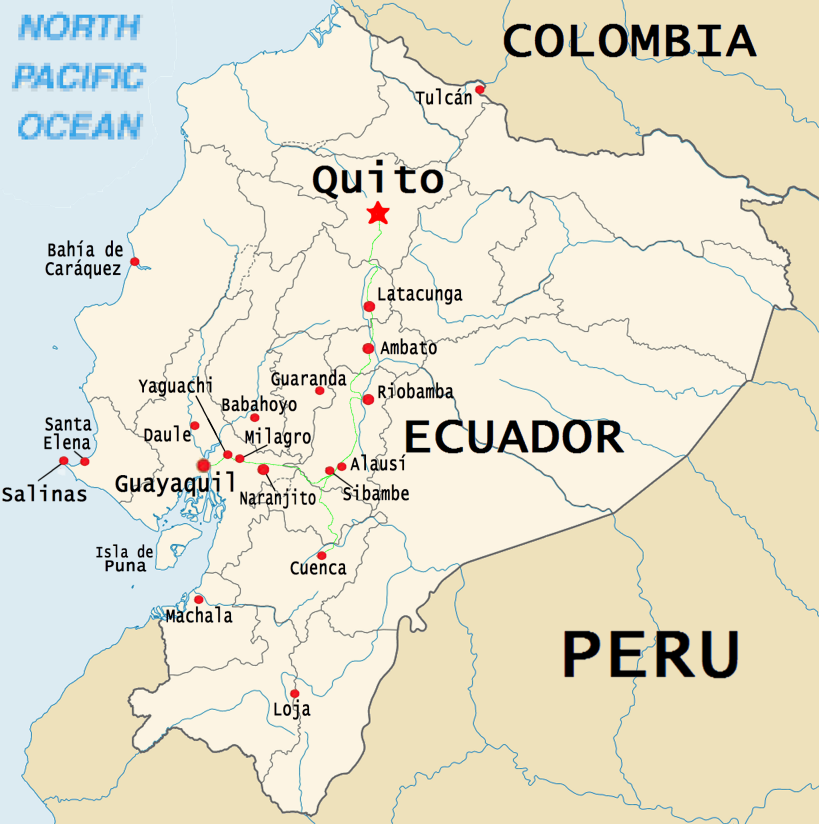
Note on seals - In Hiscocks' 2007 book on Telegraph Seals of the World, he says that perforation across the middle vertically or horizontally, was done to
convert them for use as telegraph seals. Similarly fiscal stamps were overprinted with a thick black line.
Steve Hiscocks had hoped to update it later, but unfortunately that was not to be.
The reference above has links from its pages to my updates.
Punch cancels.
In the early days, punch cancels were sometimes used rather than hand-stamps.
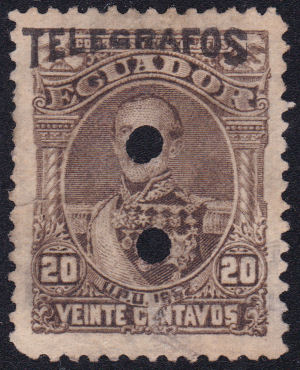
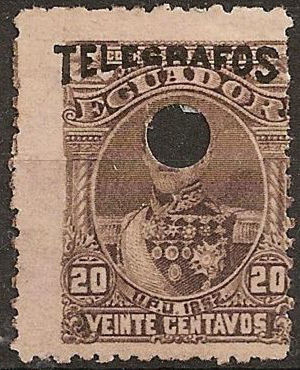
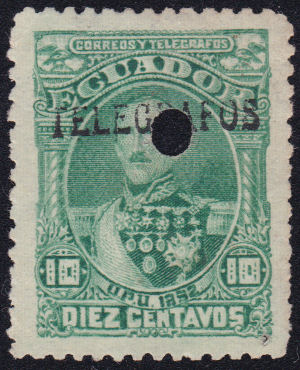
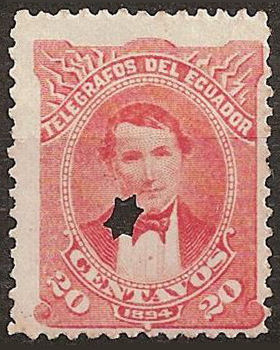
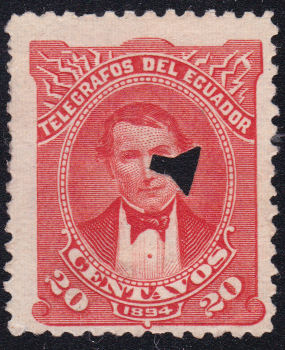
These last are fairly distinctive. The second and fourth are courtesy of K. Zwart.
According to the Ecuador Philatelic Study Group, the telegraphic service to the public was established in 1884 and, initially,
only postage stamps were used to pay the telegrams fee. These were from the 1881 and 1887 issues and were pen cancelled with the date (month/day/year), or punch cancelled.
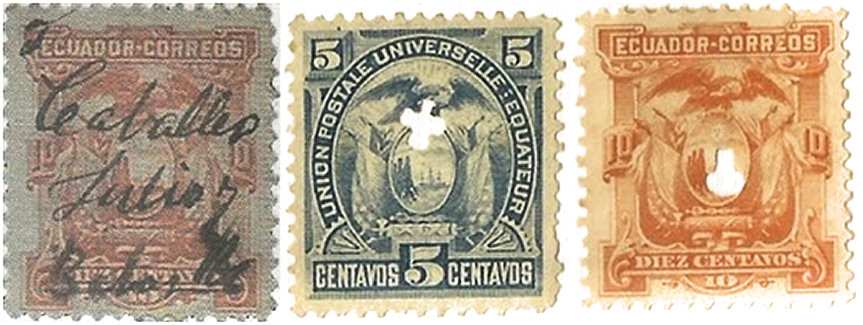
Postage stamps used telegraphically prior to the existence of telegraph stamps.
Image from the Ecuador Philatelic Study Group.
1892 (April 1) Postage stamp of 1892 (SG 34-41) overprinted 'TELEGRAFOS' as below in black or carmine. Wove paper. No watermark. Perf. 12
Sheets of 10 x 10. Image of type 1 with type 2 overprint.
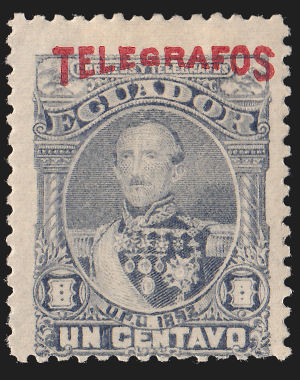 |
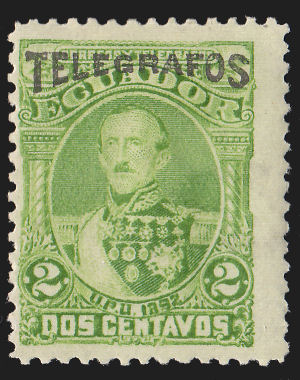 |
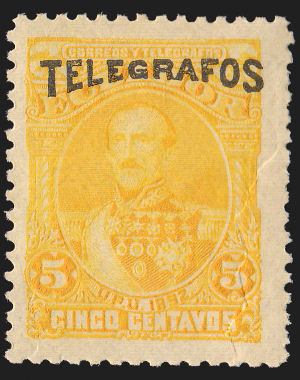 |
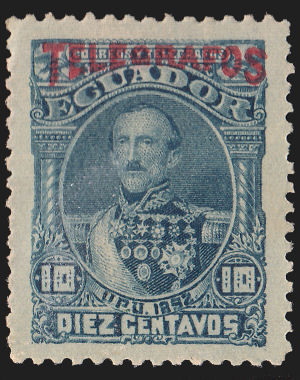 |
| 1c - RH1 | 2c - RH2 | 5c - RH3 | 10c - RH4 |
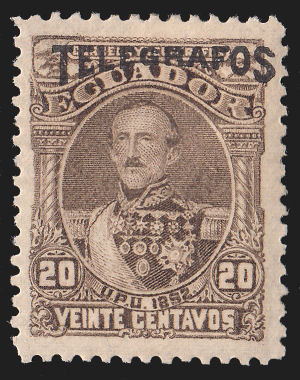 |
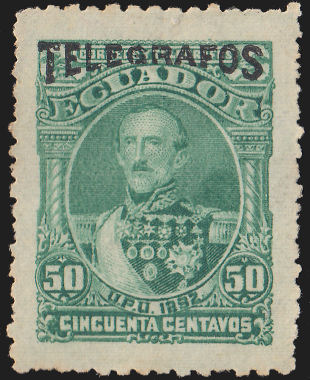 |
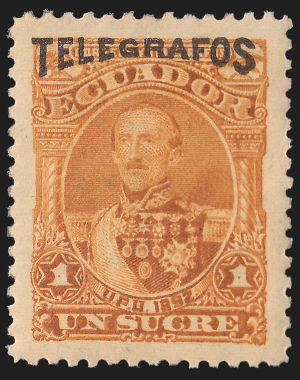 |
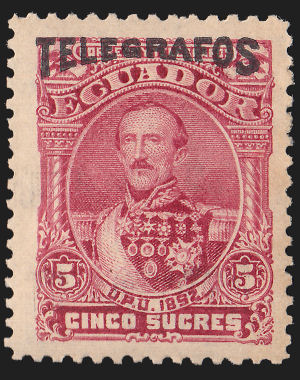 |
| 20c - RH5 | 50c - RH6 | 1s - RH7 | 5s - RH8 |
Some used examples (some apparently postally) :
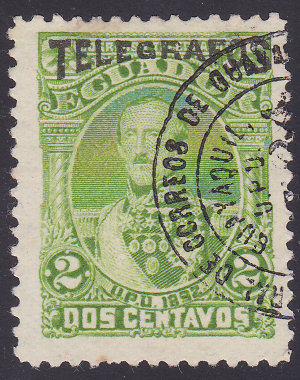 |
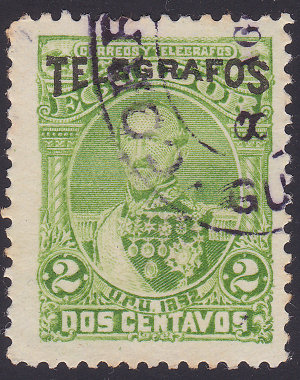 |
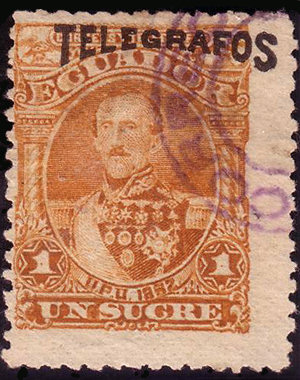 |
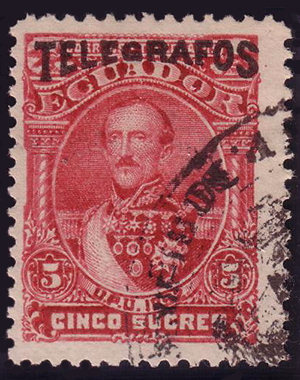 |
| A couple of used 2c stamps | Used 1s and 5s stamps - from RL. | ||
I have examples postally used with "Telegraph" cut from the top. A 2c with an 1893 cancel like the leftmost above, and a 1s with an 1898 cancel like the other 2c.
Both are on piece with very neat cancels. Given that these are Seebeck issues, it is difficult to know the status of them. There seems to have been no need to cut the tops off to use them Postally.
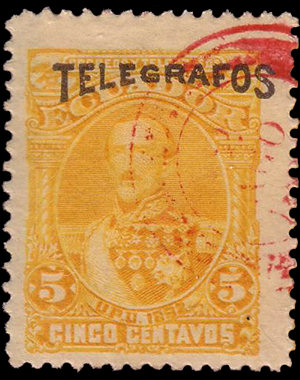 |
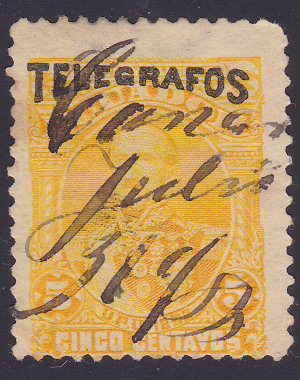 |
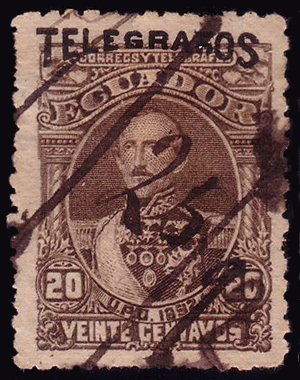 |
| A red CDS on a 5c stamp - from RL. | A manuscript cancel on a 5c stamp. | Manuscript cancel on a 20c - from RL. |
Most of these look like postal cancellations. The manuscript telegraph cancels have dates in month, day, year format.
In fact the low values were useless for the telegraph service since their minimum charge for anything was 10c for additional single words.
The 1c, 2c and 5c were used for postage or returned to Seebeck according to contract and sold by him to collectors.
The 1c and 2c values are unknown used telegraphically. The 5c, though known, is very scarce used telegraphically.
The 10c was the most needed value and they ran out. 5c were used in place of them until RH10 became available.
The 1s and 5s were also little used by the Telegraph service and most of the 5s were overprinted 5c for the postal service, see RH9.
| RH # | Hisc. | Type. | Description | Mint | Used |
|---|---|---|---|---|---|
| RH1 | H1 | 1, 2 | 1c bluish grey (carmine overprint) | 0.50 | 1.50 |
| RH2 | H2 | 1, 2 | 2c yellowish green (black overprint) | 0.50 | 1.50 |
| RH3 | H3 | 1, 2 | 5c yellow (black overprint) | 1.00 | 4.50 |
| RH3a | H3a | double overprint | 15.00 | - | |
| RH4 | H4 | 1, 2 | 10c steel blue / bluish paper (carmine overprint) | 0.50 | 1.80 |
| RH5 | H5 | 1, 2 | 20c greenish brown (black overprint) | 0.50 | 1.80 |
| RH6 | H6 | 1, 2 | 50c bluish green (black overprint) | 1.25 | 1.80 |
| RH6a | H6a | imperf. between vertical pair | 20.00 | - | |
| RH7 | H7 | 1, 2 | 1s orange-brown (black overprint) | 0.75 | 2.20 |
| RH7a | H7a | imperf. between vertical pair | 20.00 | - | |
| RH8 | H8 | 1, 2 | 5s carmine (black overprint) | 2.50 | 5.00 |
Hiscocks added the following 2 notes:
| Note 1. Cancellation was most commonly by circular date stamp (cds) in black or, rarely, blue. Oval strikes are also known. Manuscript cancellations consisting of the date and/or initials are also common and punched cancellation, usually circular but sometimes 'axe-head' shaped are less commonly found. |
| Note 2. The position of the overprint can vary both vertically and horizontally. |
My Note: There is some variability to this overprint




Much of it is due to variability in the amount of inking, but the base of the 'T' has variations.
The last one looks rather strange, but cannot be a forgery, as a forged overprint would have to be applied to postage stamps which were in different colours.
It would seem to be very watery ink.
For reference, the postal colours (according to Scott) are :
1c orange, 2c dark brown, 5c vermilion, 10c green, 20c red brown, 50c maroon, 1s blue and 5s purple.
There seem also to be other colours (trials ?). See Latin American Philatelics for a 5s in blue-green.
1893 (20 December) As above surcharged (individually) '5 CENTAVOS' in black.
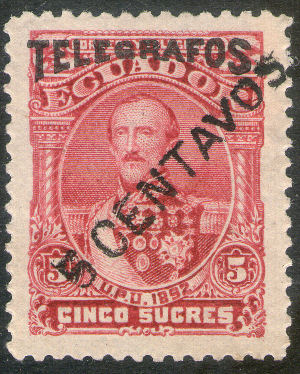
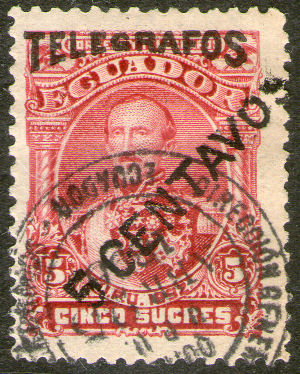 |
| Type 3 on RH8 to make RH9. |
The stamps intended for postal use, without the 'TELEGRAFOS' overprint, were printed in different colours from these.
| 1c - orange | 2c - dark brown | 5c - vermilion | 10c - green | 20c - red-brown | 50c - maroon | 1s - blue | 5s - violet |
1892(November ?) As above but with different overprint as type 4 below on the 10c postage stamp (SG37).
(These are usually listed as issued in 1893, but the earliest recorded used is 4 November 1892)
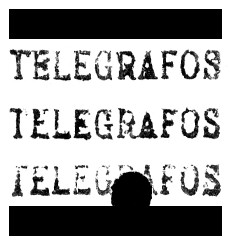 |
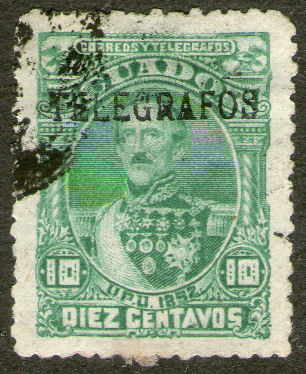 |
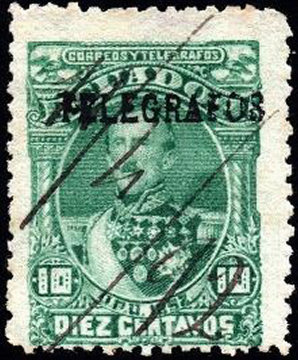 |
| Type 4 overprint examples and an example of RH10. Here are 3 examples of mine to scale, compared to a black bar 18mm long. The top example corresponds to the stamp on the right. The bottom example has a punch hole (3.5 x 4mm). The 'RA' does seem to be consistently flawed. |
Earliest known use of 4 November 1892 This was previously listed as issued in 1893. Courtesy Medio Real, January-March 2019, November 24 and 28 1892 are also known. Published by the Ecuador Philatelic Study Group. |
|
| RH # | Hisc. | Type. | Description | Mint | Used |
|---|---|---|---|---|---|
| RH10 | H10 | (1), 4 | 10c blue-green | 10.00 | 5.00 |
| RH10a | H10a | overprint inverted at base of stamp | 50.00 | - | |
| RH10b | - | (1), 4A | overprint 4A described in Note 1 | - | - |
Hiscocks added the following 2 notes:
| Note 1. The overprint on my copy of No. 10a differs in fact from that on No. 10 being some 2mm longer at 19mm and very rough with incomplete letters and a dropped 'G' — I have not seen it the right way up and view it with some suspicion. The ordinary type 4 overprint is said to exist inverted. |
| Note 2. There seem to be two positions of the overprint — at the top of the stamp and, more commonly, across the forehead of the portrait (Juan Flores). |
My note: For Type 4A see RH18 and RH20 below.
1893 New design. White wove paper. No watermark. Perf. 12
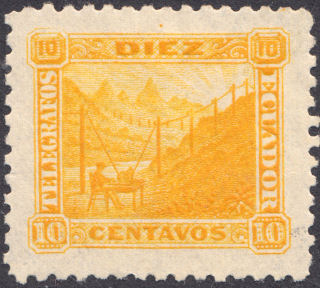 |
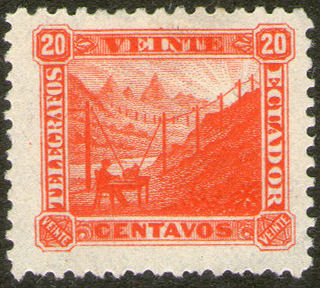 |
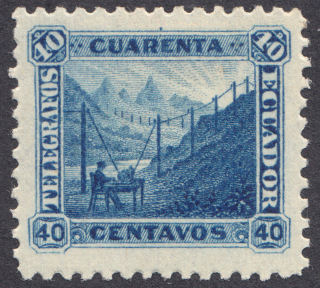 |
| Type 5 - RH11 | Type 5 - RH12 | Type 5 - RH13 |
| RH # | Hisc. | Type. | Description | Mint | Used |
|---|---|---|---|---|---|
| RH11 | H11 | 5 | 10c yellow | 6.00 | 4.00 |
| *RH11a | - | imperf. | - | - | |
| RH12 | H12 | 5 | 20c vermilion | 1.50 | 1.50 |
| RH13 | H13 | 5 | 40c deep blue | 1.50 | 2.00 |
*I have seen two imperforate proofs / colour trials as shown below, as well as an apparently used imperf. 10c in the issued colour.
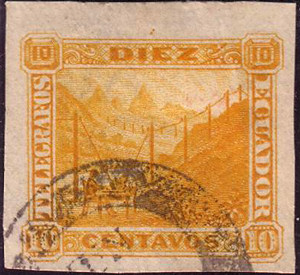 |
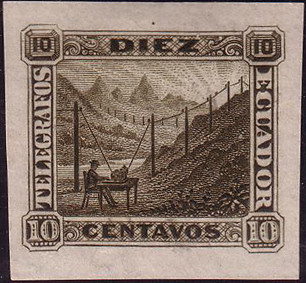 |
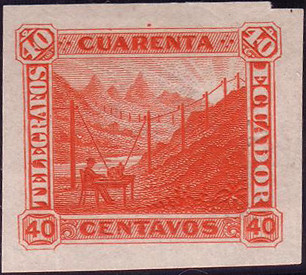 |
| Images from RL. | ||
1894 New design (President Rocafuerte). White wove paper. No watermark. Perf. 12. Sheets of 100 (10x10).
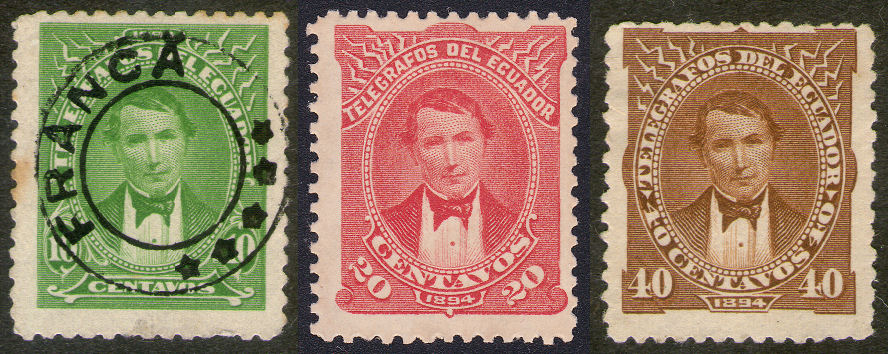 |
| Types 6, 7 & 8 — Type 6 is cancelled to order. |
| RH # | Hisc. | Type. | Description | Mint | Used |
|---|---|---|---|---|---|
| RH14 | H14 | 6 | 10c yellow-green | 6.00 | 3.00 |
| RH15 | H15 | 7 | 20c vermilion | 2.00 | 1.50 |
| RH15a | H15a | dull scarlet | 10.00 | 6.00 | |
| RH16 | H16 | 8 | 40c reddish-brown | 9.00 | 6.00 |
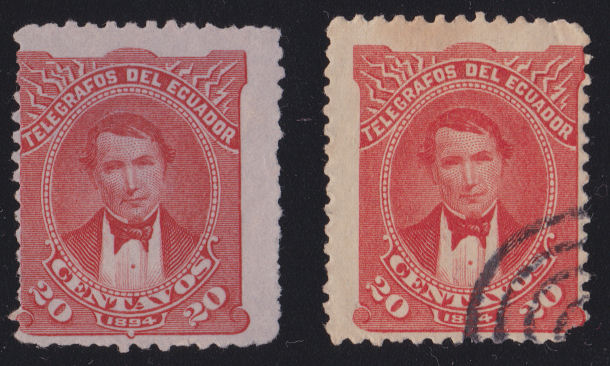
An interesting pair (scanned together). The one on the left has strangely white paper.
The one on the right has the usual creamy paper, but with a cancel that is unusual for Ecuador, as well as having full gum.
I am told by K. Zwart that this cancel was used for cancelled to order after 1900. I am also told that there were reprints of the 20c,
with the original being vermilion on a fine weave paper and the reprint being dull vermilion on a 'strong' weave paper.
Perhaps H15a represents the reprint, or
possibly H15a is the stamp on the left.
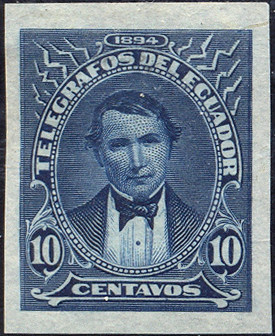
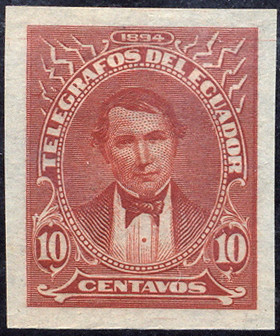
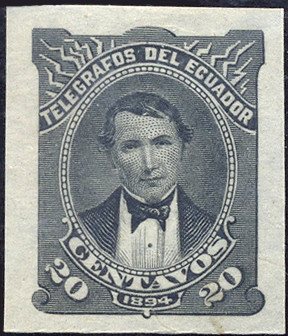
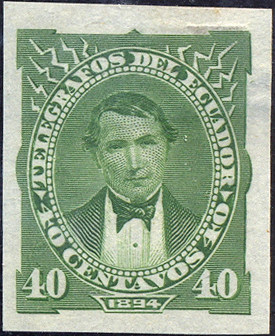
Some imperforate colour trials ? - from RL.
Steve Hiscocks added the following note:
| Note. While all the cancellations mentioned in Note 1 below No. 8 above are found, punched cancellations are now more common and varied. They include: circles of various sizes, rough triangles, 'funnel' and 'chalice'. The 'axe-head', quite common in the 1893 issue, appears to have dropped out. |
The above stamps are dated 1894 and there is an equivalent postal version dated 1894 which was then followed
by the same, but dated 1895, followed by a new design dated 1896.
This implies that the annual nature of the Seebeck contract (see note at the beginning) was taken very seriously.
However there were no new Seebeck Telegraph designs supplied. This necessitated improvisation.
Initially outdated 10c Fiscal Stamps were overprinted for Telegraphic use. For 1895 they were not dated as such,
but in 1896 it appears that a manuscript '1896' was additionally added.
Notes on the Forbin listing:
For simplicity I will confine this to the 10c value since it is the only one known to have been used for these, and prefix his numbers with 'F'.
Forbin says that all the stamps before 1884 were essays. F1 to F5 are undated for values of 1c, 2c, 5c, 20c, 50c respectively.
F6 to F11 are engraved with a date of 1881-1882 for the same values, but now including a 10c orange as F9.
F12 is F5(50c) surcharged with 1881-1882,
F12a is F3(5c) surcharged with 1883-1884,
F13 to F15 is F1 to F5 plus an additional 10c yellow orange(F16) and 1p overprinted 1884-1885 in the date tablet.
F16 was issued for its fiscal purpose and appears to have played no part in telegraphic use.
| Forbin # | Issued | Description | *Postal use | *Hiscocks | RH # | *T | Note |
|---|---|---|---|---|---|---|---|
| F23B | 1886 | F9 surcharged 1886-1887. | - | - | RH17 | Yes | |
| F30 | 1887 | Engraved 1887-1888. | Sc72/72c | - | RH18 | Yes | |
| F37 | 1889 | F30 surcharged 1889-1890. | - | - | RH19 | No | 1 |
| F44 | 1891 | F30 surcharged 1891-1892. | - | - | RH20 | Yes | |
| F51 | 1891 | Engraved 1891-1892. | - | H17, H18 | RH21 | Yes | |
| F58A | 1893 | F30 surcharged 1893 y 1894. | - | H19?, H20 | RH22 | Yes | 2 |
| F66 | 1893 | Engraved 1893-1894. | Sc72d | H19? | RH23 | Yes | 2 |
| F73 | 1895 | Engraved 1895-1896. | - | - | - | No | 3 |
* Some were also overprinted for postal use in 1896.
* Basic stamp, ignoring the uncertainty of overprint.
* Seen and illustrated with Telegraph overprints.
My notes:
| Note 1. Forbin says there are 2 types of this surcharge. |
| Note 2. Hiscocks described H19 and H20 as being on F66, but illustrates H19 on F58A. |
| Note 3. The 1895 issue was in new colours. This stamp was printed in grey. |
| Note 4. F30 was also overprinted for postal purposes in November 1896. |
1894-5 Fiscal stamps of 1886 to 1893 overprinted 'TELEGRAFOS' of type 4A or type (10) diagonally in black.
White wove paper. No watermark. Perf. 12
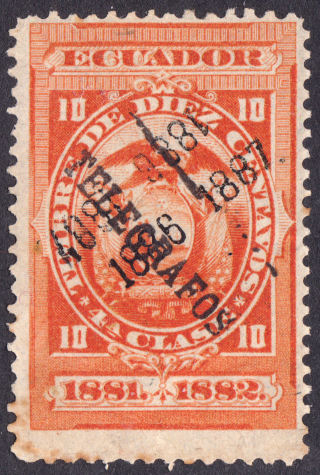 |
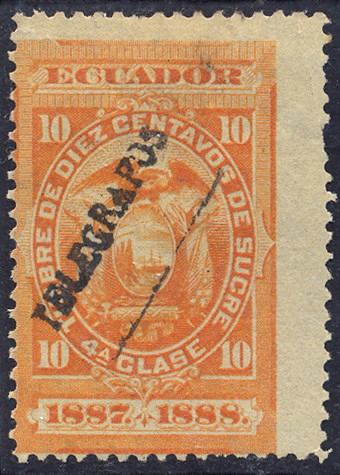 |
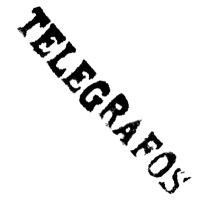 |
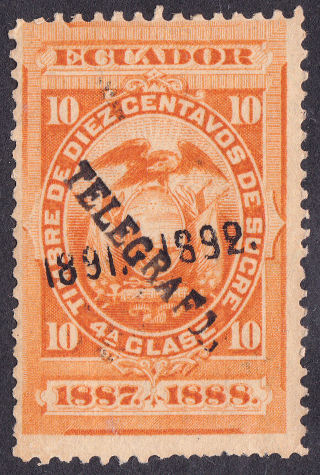 |
| RH17a, Type 4A on Forbin 23B (double overprint). |
RH18, Type 4A on Forbin 30. Image from RL |
Type 4A I have called it that because it matches the description in Note 1 under H10. |
RH20, Type 4A on Forbin 44 |
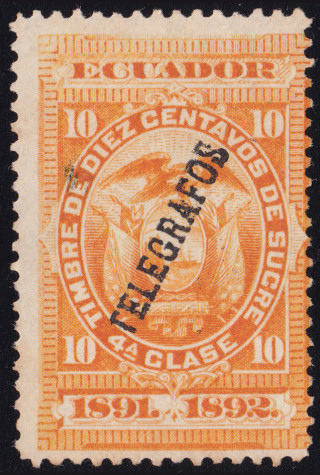 |
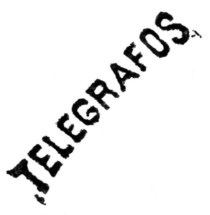 |
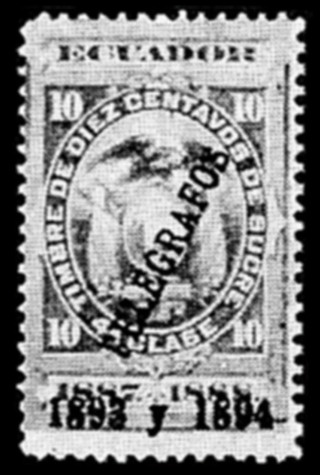 |
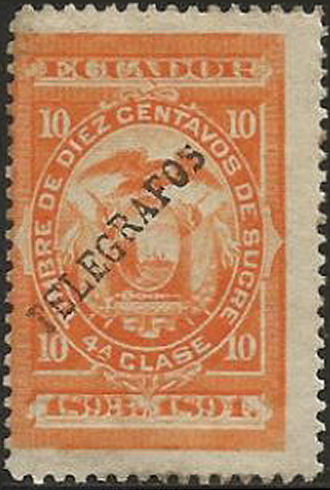 |
| RH21, Type 9 (on Forbin 51) | Type 10 overprint. | RH22, Type 11 (on Forbin 58A) from Hiscocks' book page 96. |
RH23, Type 4a on Forbin 66 courtesy of K. Zwart. |
Walter Morley (1900) listed Type 9 and a variety with larger overprint.
Can anyone supply a scan of RH22 ?
Anyone have more (similar) types?
| RH # | Hisc. | Type. | Description | Mint | Used |
|---|---|---|---|---|---|
| RH17 | - | (9), 4A | 10c orange (1886/7, Forbin 23B) | - | - |
| RH17a | - | 1886 1887 overprint double | - | - | |
| RH18 | - | (9), 4A | 10c orange (1887-8, Forbin 30) | - | - |
| RH19 | - | (9), 4A | 10c orange (1889-90, Forbin 37) | - | - |
| RH20 | *H18 | (9), 4A | 10c orange (1891/2, Forbin 44) | - | - |
| RH21 | H17 | 9 | 10c orange (1891/2, Forbin 51) | 15.00 | 5.00 |
| RH21a | H17a | overprint double | 30.00 | 15.00 | |
| RH22 | H19 | 11 | 10c orange (1893/4, Forbin 58A) | 25.00 | 20.00 |
| RH23 | *H20 | (11), 4A | 10c orange (1893/4, Forbin 66) | - | - |
Hiscocks added the following 3 notes:
| Note 1. Nos. *18 and 20 have been reported but I have seen no other evidence for their existence. |
| Note 2. All used copies I have seen (about 20) have been cancelled with a 'funnel' shaped punch. |
| Note 3. The overprint on No. 17 is 17mm long and seems very similar to that on No. 10. That on No. 19 is of identical type but 19mm long. The left hand arm of the 'T' is missing in both cases. The overprints seem to have been applied with a rubber stamp leading to slightly different heights of letters depending on the angle at which the stamp was applied. |
*My note: Hiscocks listed H18 and H20 as having overprint Type 10.
They are actually the type I have illustrated as Type 4A.
1896 The only candidates I have seen are these. Manuscript 1896 on 1894 and 1895 issues.
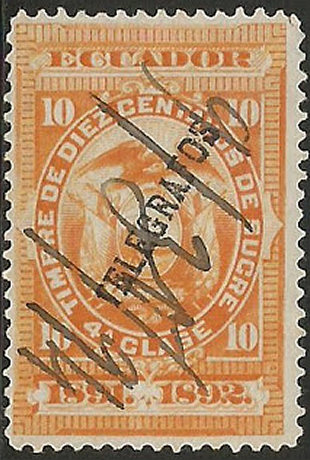 |
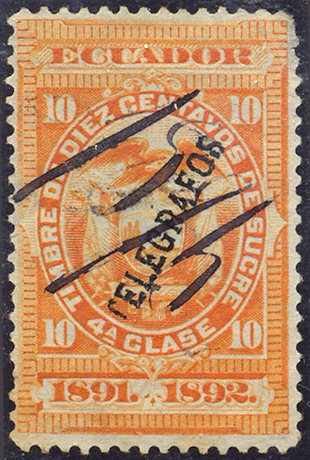 |
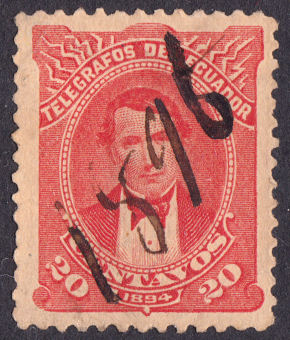 |
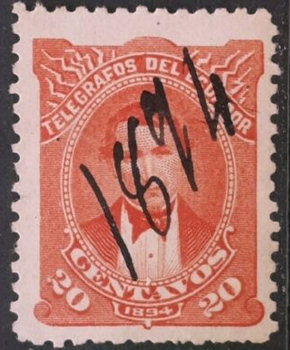 |
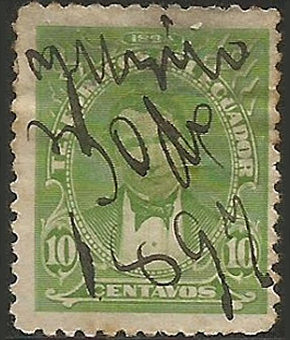 |
| RH21, Type 9 with manuscript cancel of 30 September 1894. Hiscocks dated these 1895 Image from the Ecuador Philatelic Study Group. |
RH24, Type 9 with manuscript '1896' (on RH21 of 1894/5) - From RL |
RH26, Type 7 with manuscript '1896' (on RH15 of 1894) |
With manuscript '1894' Unlike the later overprints, these were simply cancels, authorized or not, since they had to use something and could only use what they had. |
RH14 used in 1897 with no overprint. These were later overprinted, see below. Image from the Ecuador Philatelic Study Group. |
It is uncertain what was used in 1896.
For postal use there were UPU issues for 1895 and 1896, but for telegraphic use things appear to have largely been improvised.
The 1895 stamps were not specifically dated as such, but were there sufficient stocks at all offices ?
They went through a lot of different 10c Fiscals.
I will list the set, plus RH21 with manuscript overprints, since they are reasonably convincing
and I need to re-number things now anyway (hopefully for the last time).
| RH # | Hisc. | Type. | 1896 Description | Mint | Used |
|---|---|---|---|---|---|
| RH24 | - | 9 | 10c orange (RH21) | - | - |
| RH25 | - | 6 | 10c yellow-green (RH14) | - | - |
| RH26 | - | 7 | 20c vermilion (RH15) | - | - |
| RH27 | - | 8 | 40c reddish-brown (RH16) | - | - |
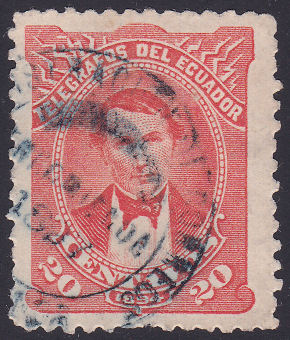 |
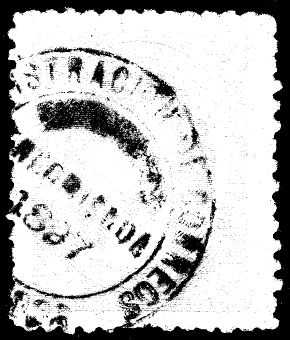 |
|
| 1897 This is an interesting item. It has only the year of 1897, but no month, day or time, but instead a word that I could not read. Around the top this appears to say 'ADMINISTRACION DE CORREOS'. |
Thanks to K. Zwart I now know that the cancel reads 'ENCOMIENDA' (Ensure), though I would expect that in 1897 this would have an appropriate overprint. Anyway, this does not appear to be telegraphic. |
|
1897 Fiscal stamps of 1897/8 (Forbin 92-96 but not issued as a fiscal stamp) overprinted as above.
White wove paper. No watermark. Perf. 14
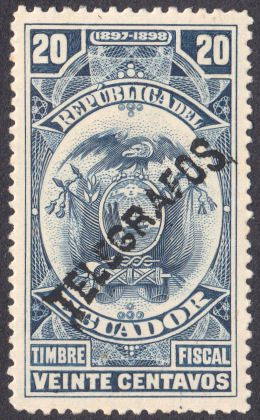
Type 12 with Type 10 overprint - RH28
| RH # | Hisc. | Type. | Description | Mint | Used |
|---|---|---|---|---|---|
| RH28 | H21 | 12, 10 | 20c steel blue | 3.00 | 5.00 |
| RH29 | H22 | 12, (4) | 20c steel blue | - | - |
Hiscocks added the following note:
| Note. No. 22 has been listed elsewhere but again I have seen no evidence of its existence. |
Can anyone supply a scan of RH29 (overprint type 4 or 4A) ?
1897 Stamps of 1894 (Nos. 14-16) overprinted '1897 - 1898' in six types as below in black.
White wove paper. No watermark. Perf. 14
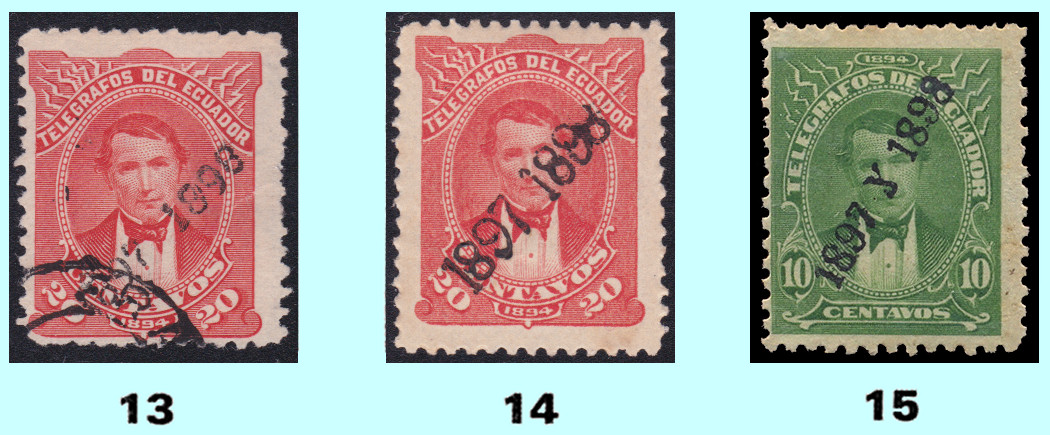 |
| As Hiscocks' book page 96. - Type 15 is from RL |
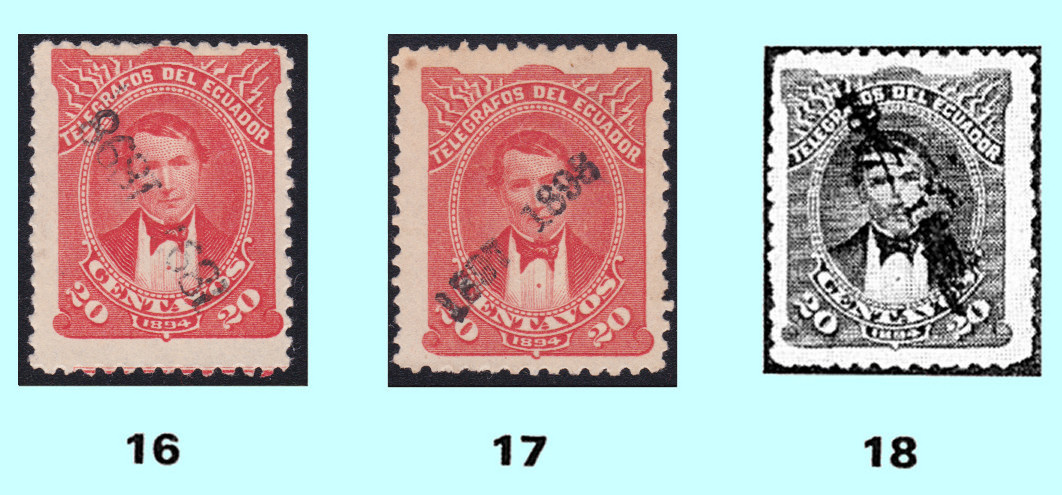 |
| My example of Type 16 is inverted. I have added it below as *RH38a. Type 17 is courtesy of Iain (gloriosa2000 on eBay). |
Hiscocks added the following 3 notes:
| Note 1. These overprints would appear to be handstamped with rubber stamps and are variable with respect to both orientation and exact dimensions of the numerals. The dimensional variability can make separation of the types difficult. Taking each type in turn :— 13 About 17.8mm long by 2.8mm high. Diagonally bottom left to top right in 90% of cases and top left to bottom right in remainder. The most common type. Quality of overprint very varied, probably with age of rubber stamp. 14 About 18.2mm long by 3.8mm high but numerals can be 'stretched' to as much as 4.5mm high by stamping process. About equally top left to bottom right and bottom left to top right. 15 About 19mm long by 2.8mm high. '1897 y 1898' and thus easily distinguished. Top left to bottom right in most cases. 16 Very similar to type 14 but numerals about 3.3mm high. Apparently equally common in both orientations. 17 Very similar to type 13 but the '9's curl upwards at the bottom. 18 Found only on the 20c and quite distinct. About 19mm long with stops after both dates. Numerals '1' about 2mm and other numerals 3mm with '8's extending upwards by 1mm and '9's and '7' extending downwards by 1mm. This overprint is so different from the others its status must be in doubt (see note below). |
| Note 2. All the above overprints were applied to prevent the use of large quantities of stamps (both postage and telegraph) which had been stolen. Perhaps the overprint of type 18 (No. 33) was applied by the thieves to counter this measure! |
| Note 3. The majority of these stamps were cancelled in manuscript in use although cds cancellations are found. Punched cancellations were by now very rare. |
My note: For 1895 and 1896 there were Seebeck UPU stamps supplied for postal use.
After that, these overprints were used on postage stamps and also on the telegraph stamps of 1894 and 1895.
The original plan was that the outdated stamps should be returned to Quito to be overprinted '1897-1898' for
the purposes of validating them for use and making use of outdated stock. The problem was that most of the provincial
offices did not comply with the order to return the old stock. Instead some continued to be used without overprint
and some had overprints made locally for use. There are therefore different categories of these overprints.
The Official ones, created in Quito and delivered to the provinces of Guayas, Esmeraldas, El Oro, Manabí and Loja;
Local issues created by local postmasters for genuine use;
Private ones created by individuals with large stocks of un-overprinted stamps and those created purely for philatelic purposes.
This is well written up by Georg Maier and published in Boletín No.11 of April 2013 by the Asociatión Filatélica Ecuatoriana of Quito.
Two covers are shown from Guayaquil and one from Quito which should all have had the Official overprint. The stamps on them had overprint Type 17.
The Ecuador Philatelic Study Group recognises 5 types in the first two categories.
They do not include
Type 18, so perhaps Hiscocks was right in his Note 2 above.
1897 Stamp of 1894 (No. 15) surcharged as below.
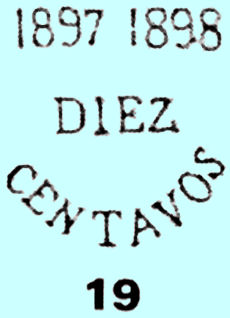
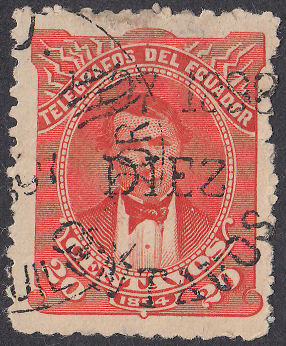 |
| Type 19 from Hiscocks book page 98, together with an example of RH43. |
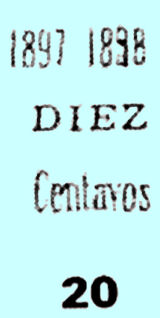
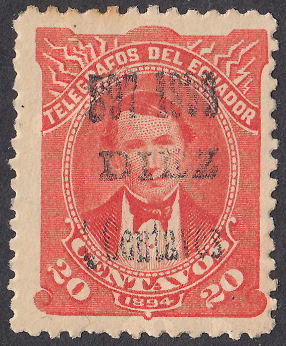
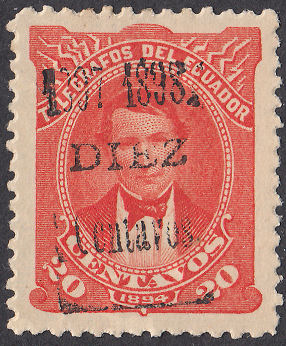 |
| Type 20 from Hiscocks book page 98, together with examples of RH47 and RH47a. |
| RH # | Hisc. | Type. | Description | Mint | Used |
|---|---|---|---|---|---|
| RH46 | H39 | 7, 19 | 10c on 20c vermilion | 7.50 | 5.00 |
| RH47 | H40 | 7, 20 | 10c on 20c vermilion | 7.50 | 5.00 |
| RH47a | H40a | strengthened '1' in '1897' | 15.00 | 10.00 |
Hiscocks added the following note:
| Note. Completely legible strikes of both 19 and 20 are rare. In particular the '1' of '1897' in 20 is normally completely absent and this was evidently replaced with a rather thicker '1' of the same height. It is quite distinct in being much more heavily printed than the rest of the overprint when present. |
Anyone know what was used in the first half of 1899?
August 1899 New design (Waterlow & Sons Ltd.,) black centre medallions.
White wove paper. No watermark. Perf. 14
 |
| Types 21, 22 and 23. It looks like the 20c colours can change. |
According to K. Zwart this colour change is due to the use of lead in the pigment. It is thus similar to the early British red and blue stamps that became darkened due to the presence
of hydrogen sulphide or sulpher dioxide in the atmosphere creating lead sulphate in the pigment. Treatment with dilute hydrogen peroxide or vapour from it, can reverse the process,
but requires great care, particularly in the case of mint stamps.
1911-1913 ? Fiscal stamps dated 1911-1912 (Forbin 181 etc.) or 1913-1914 (Forbin 190 etc.) as indicated, and overprinted 'TELEGRAFOS' in black (26.5mm x 3.4mm).
Reading downwards. White wove paper. No watermark. Perf. 12
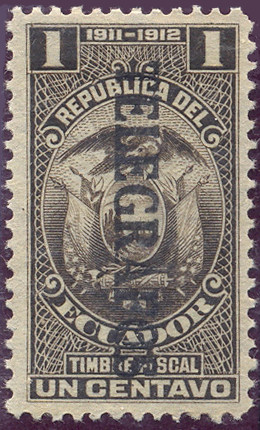 |
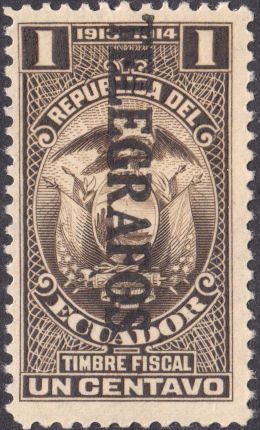 |
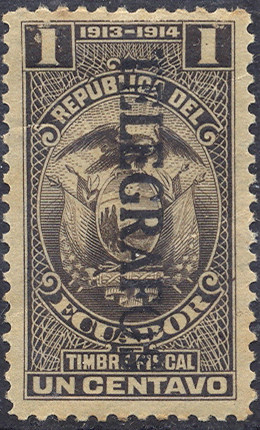 |
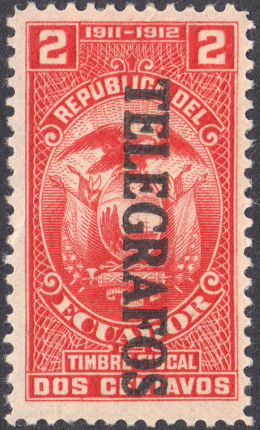 |
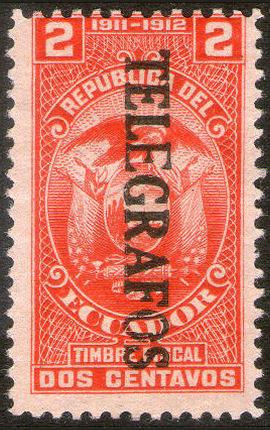 |
| Type 24. RH51 - from RL | Type 24. RH52. | Type 24. RH52b - from RL | Type 24. RH53. | Type 24. RH53a. |
| RH # | Hisc. | Type. | Description | Mint | Used |
|---|---|---|---|---|---|
| RH51 | H44 | 24 | 1c sepia (1911-1912) | 3.75 | 5.00 |
| RH51a | H44a | second 'E' larger and thinner | 7.50 | 10.00 | |
| RH51b | H44b | 'O' larger and thinner | 7.50 | 10.00 | |
| RH52 | H45 | 24 | 1c sepia (1913-1914) | 5.00 | 7.50 |
| RH52a | H45a | second 'E' larger and thinner | 10.00 | 12.50 | |
| RH52b | H45b | 'O' larger and thinner | 10.00 | 12.50 | |
| RH53 | H46 | 24 | 2c bright scarlet (1911-1912) | 5.00 | 5.00 |
| RH53a | H46a | second 'E' larger and thinner | 10.00 | 10.00 | |
| RH53b | H46b | 'O' larger and thinner | 10.00 | 10.00 |
Hiscocks added the following note:
| Note. Used copies are normally cancelled with large circular or oval purple stamps. |
My note: These are traditionally listed as being issued in 1919, but evidence has come to light that these were actually invalidated before that
and being used as telegram seals by 1917. It is considered likely by Juan Pablo Aguilar that the overprint was undated because the Fiscal date on them was correct.
Further information would be welcome.
For about the next 35 years, various Fiscal stamps similar to those above were used to create Telegraph stamps.
To make it easier to identify them, I have created a table.
1919 As above but overprinted 'TELEGRAFOS / 1919—1920' reading upwards or downwards.
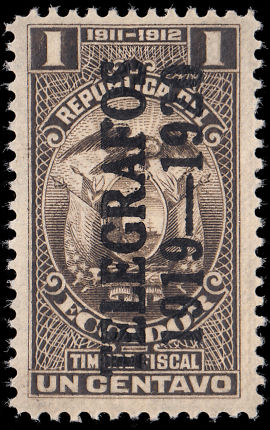 |
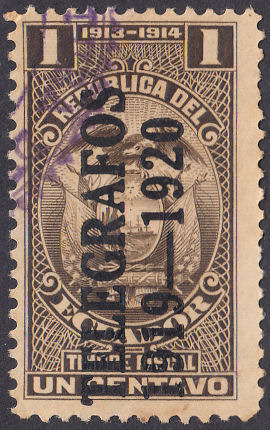 |
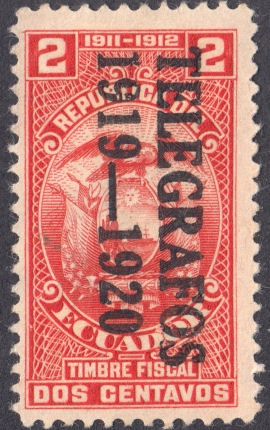 |
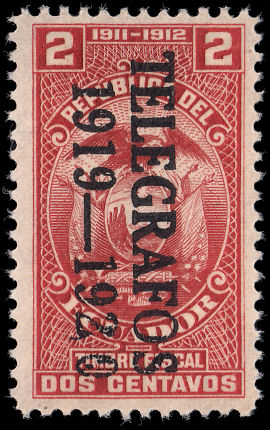 |
| Hiscocks Type 25, RH54 reading upwards. |
Hiscocks Type 25, RH55 reading upwards. |
Hiscocks Type 25, RH56 reading downwards. |
Hiscocks Type 25, RH56b/c reading downwards. |
For H56b/c see Hiscocks Note 2 below.
| RH # | Hisc. | Type. | Description | Mint | Used |
|---|---|---|---|---|---|
| RH54 | H47 | 25 | 1c sepia (1911-1912) | 3.75 | 5.00 |
| RH54a | H47a | second 'E' larger and thinner | 7.50 | 10.00 | |
| RH54b | H47b | 'O' larger and thinner | 7.50 | 10.00 | |
| RH55 | H48 | 25 | 1c sepia (1913-1914) | 3.75 | 5.00 |
| RH55a | H48a | second 'E' larger and thinner | 7.50 | 10.00 | |
| RH55b | H48b | 'O' larger and thinner | 7.50 | 10.00 | |
| RH56 | H49 | 25 | 2c bright scarlet (1911-1912) | 5.00 | 7.50 |
| RH56a | H49a | second 'E' larger and thinner | 7.50 | 10.00 | |
| RH56b | H49b | 'O' larger and thinner | 7.50 | 10.00 | |
| RH56c | H49c | spaced between '2' and '0' in '1920' | 7.50 | 10.00 | |
| RH57 | H50 | 25 | 2c bright scarlet (1913-1914) | 10.00 | 12.50 |
| RH57a | H50a | second 'E' larger and thinner | 12.50 | 15.00 | |
| RH57b | H50b | 'O' larger and thinner | 12.50 | 15.00 | |
| RH57c | H50c | spaced between '2' and '0' in '1920' | 12.50 | 15.00 |
Hiscocks added the following notes:
| Note 1. The registration between the 'TELEGRAFOS' and the '1919—1920' varies although both were apparently applied together. |
| Note 2. In my specimens the large 'O' and spaced '20' varieties occur on the same stamps. It is not clear whether the latter is a separate variety. |
| Note 3. Omissions of letters due to poor printing occur. |
| Note 4. Unlike Nos. 44-46 where the overprints seem always to read downwards, the overprints on Nos. 47-50 seem to read upwards or downwards in roughly equal quantities. I have not regarded these as separate varieties. |
1920 As above but overprinted 'TELEGRAFOS / 1920—1921' in carmine.
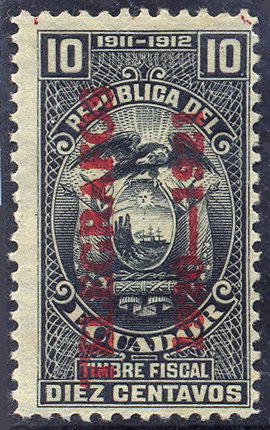 |
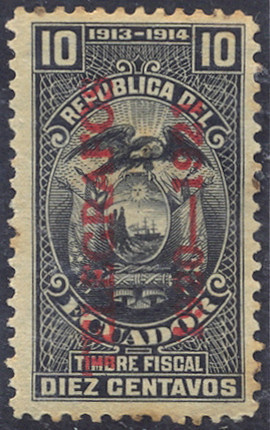 |
| Type 26, RH58 from RL | Type 26, RH59 from RL |
| RH # | Hisc. | Type. | Description | Mint | Used |
|---|---|---|---|---|---|
| RH58 | H51 | 26 | 10c black (1911-1912) | 25.00 | 25.00 |
| RH59 | H52 | 26 | 10c black (1913-1914) | 40.00 | 40.00 |
Hiscocks added the following note:
| Note. Overprints appear to read up or down in roughly equal quantities. |
According to the Ecuador Philatelic Study Group, on November 12, 1919 (Official Gazette 942 of November 13, 1919),
the National Congress established that, as
of January 1 of the following year, an additional cent per word be added to
the telegraphic rate, so that the
product it is used in the construction of roads for the east and in the establishment
of military colonies (fifty percent for each of these two purposes). "Region Oriental" was overprinted on stamps to indicate this purpose.
1920 As above but overprinted 'TELEGRAFOS / Region Oriental / 1920—1921' upwards or downwards.
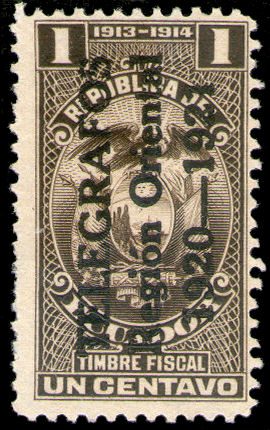 |
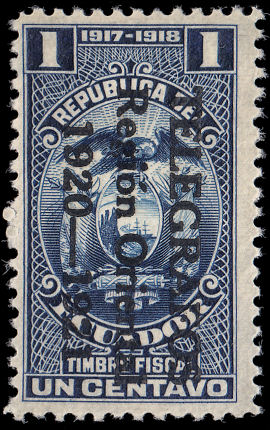 |
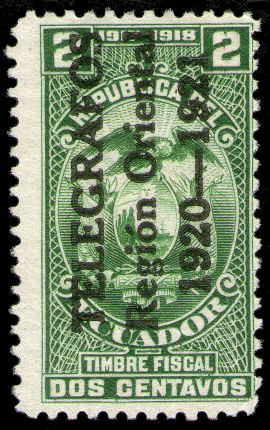 |
| Hiscocks Type 27, RH60 reading upwards. |
Hiscocks Type 27, RH61 reading downwards. |
Hiscocks Type 27, RH62 reading upwards. |
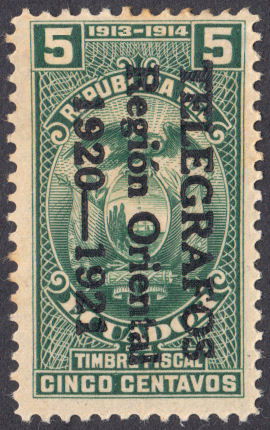 |
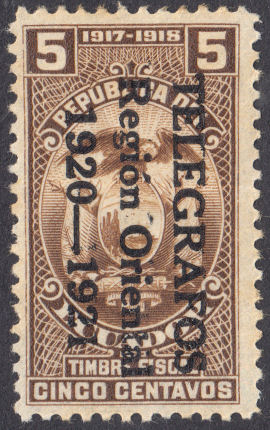 |
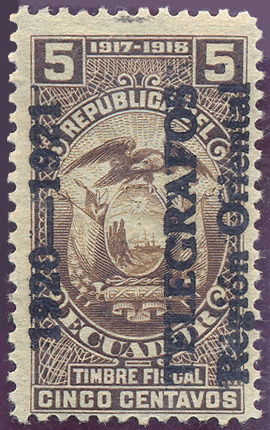 |
| Hiscocks Type 27, RH63 reading downwards. |
Hiscocks Type 27, RH64 reading downwards. |
Hiscocks Type 27, RH64a - from RL |
| RH # | Hisc. | Type. | Description | Mint | Used |
|---|---|---|---|---|---|
| RH60 | H53 | 27 | 1c sepia (1913-1914) | 10.00 | 5.00 |
| RH61 | H54 | 27 | 1c deep blue (1917-1918) | 20.00 | 15.00 |
| RH62 | H55 | 27 | 2c green (1917-1918) | 7.50 | 5.00 |
| RH63 | H56 | 27 | 5c green (1913-1914) | 15.00 | 10.00 |
| RH64 | H57 | 27 | 5c brown (1917-1918) | 7.50 | 5.00 |
| RH64a | H57b | overprint misplaced 12mm to left | 10.00 | - |
Hiscocks added the following 2 notes:
| Note 1. My copy of No. 57(b) has just the dates (1920-1921) up the left margin of the stamp. It is thus a 12mm shift to the left rather than a 7mm shift to the right [SIC ?]. |
| Note 2. The overprints on Nos. 53-57 and on No. 58 below again read upwards or downwards in roughly equal proportions. |
1920 'Patriotic Stamp' (i.e. fund-raising tax stamp) of 1920 overprinted as above in black, reading upwards or downwards.
White wove paper. No watermark. Perf. 12
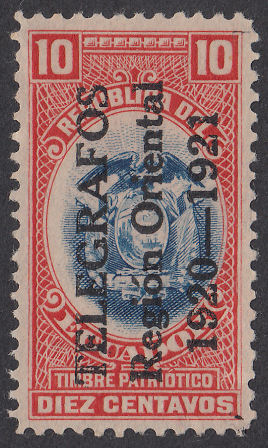
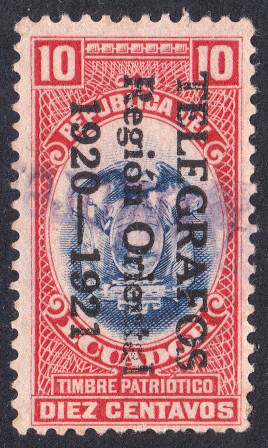
Hiscocks Type 28 (RH65)
| RH # | Hisc. | Type. | Description | Mint | Used |
|---|---|---|---|---|---|
| RH65 | H58 | 28 | 10c red and blue (centre) | 15.00 | 15.00 |
1922 Telegraph stamps ('Region Oriental' above value at bottom and 'Impuesto Adicional' at the top).
White wove paper. No watermark. Perf. 12
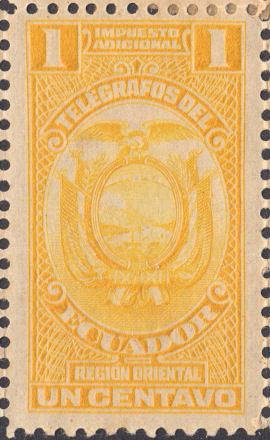 |
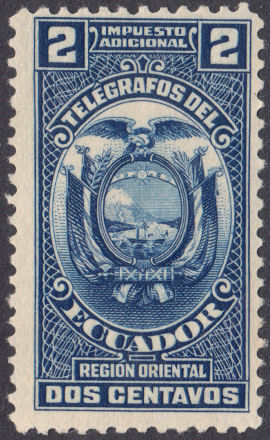 |
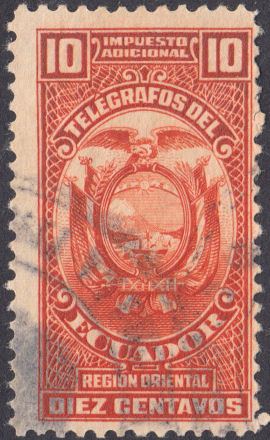 |
| Type 30 - 1c, RH66 | Type 30 - 2c, RH67 | Type 30 - 10c, RH68 |
| RH # | Hisc. | Type. | Description | Mint | Used |
|---|---|---|---|---|---|
| RH66 | H59 | 30 | 1c orange-yellow | 10.00 | 5.00 |
| RH67 | H60 | 30 | 2c deep blue | 10.00 | 5.00 |
| RH68 | H61 | 30 | 10c vermilion | 10.00 | 4.00 |
Hiscocks added the following note:
| Note. Nos. 59 and 60 were also overprinted 'Casa de Correos y Telegrafos de Guayanas' in blue for postal use. |
1922 Telegraph stamps ('Timbre Fiscal' above value at bottom).
White wove paper. No watermark. Perf. 12
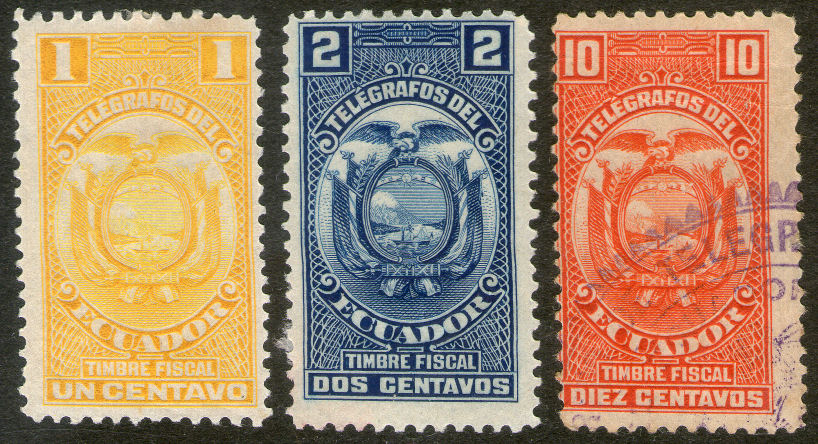 |
| Hiscocks Type 31. |
| RH # | Hisc. | Type. | Description | Mint | Used |
|---|---|---|---|---|---|
| RH69 | H62 | 31 | 1c orange-yellow | 10.00 | 5.00 |
| RH70 | H63 | 31 | 2c deep blue | 10.00 | 5.00 |
| RH71 | H64 | 31 | 10c vermilion | 10.00 | 4.00 |
The 10c is known used in 1925, bisected on a form which is shown below.
Hiscocks added the following note:
| Note. Stamps of the same design as Nos. 62-64 but in different colours were issued in 1928, 1939 and 1945. |
1922-3 Various telegraph stamps overprinted 'CENTENARIO / GUAYAQUIL / 1921—1922' (32) or '1923—1924' (33) in black. (See note below)
White wove paper. No watermark. Perf. 12
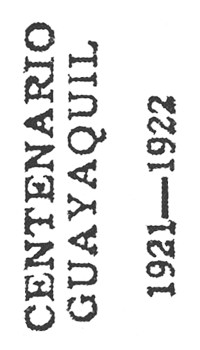 |
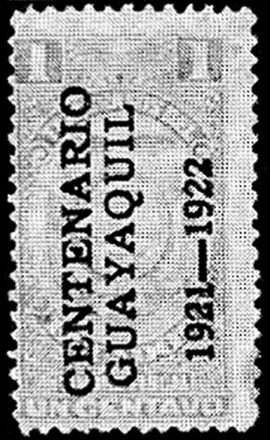 |
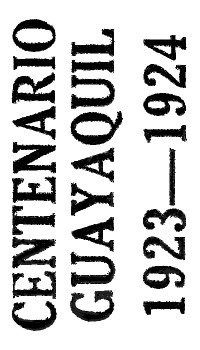 |
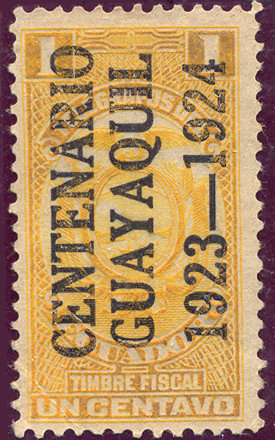 |
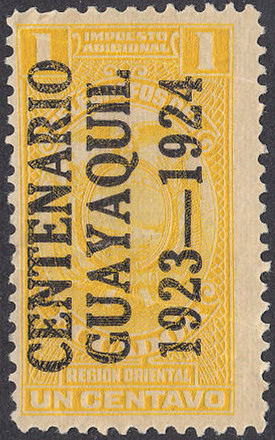 |
| Type 32 - Normally reading upwards. | RH72 - (on Type 31) from Hiscocks book. | Type 33 - Normally reading upwards. | RH77 - (33 on Type 31) from RL | *RH77A - (33 on Type 30) |
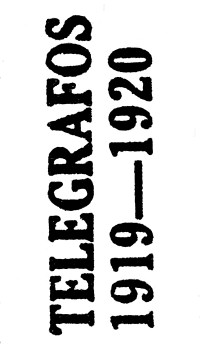 |
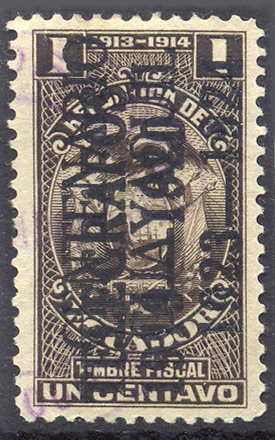 |
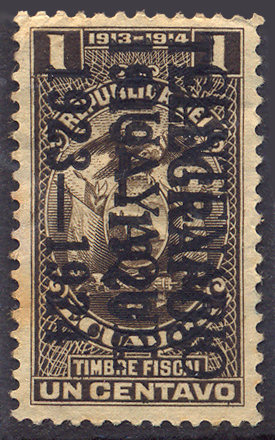 |
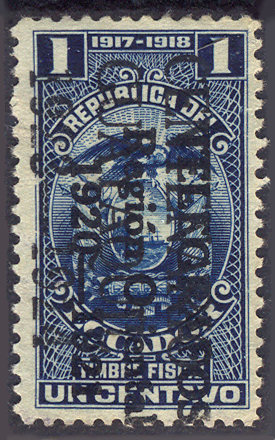 |
| Type 25 (reading up or down) | RH75 - from RL | *RH75c - (33 reading down) from RL | *RH76a - (27+33 reading down) from RL |
| RH # | Hisc. | Type. | Description | Mint | Used |
|---|---|---|---|---|---|
| RH72 | H65 | 31, 32 | 1c orange-yellow (RH69) | 15.00 | 15.00 |
| RH73 | H66 | 24, 33 | 1c sepia (RH51, 24 downwards) (1911-1912) | 15.00 | 15.00 |
| RH73a | H66a | second 'E' in 'TELEGRAFOS' larger and thinner. | 20.00 | 20.00 | |
| RH73b | H66b | 'O' larger and thinner | 20.00 | 20.00 | |
| RH74 | H67 | 25, 33 | 1c sepia (RH54, 25 up or down) (1911-1912) | 15.00 | 15.00 |
| RH74a | H67a | second 'E' larger and thinner | 20.00 | 20.00 | |
| RH74b | H67b | 'O' larger and thinner | 20.00 | 20.00 | |
| RH74c | †H67c | 33 reading downwards | 30.00 | 30.00 | |
| RH75 | H68 | 25, 33 | 1c sepia (RH55, 25 up or down) (1913-1914) | 15.00 | 15.00 |
| RH75a | H68a | second 'E' larger and thinner | 20.00 | 20.00 | |
| RH75b | H68b | 'O' larger and thinner | 20.00 | 20.00 | |
| *RH75c | - | 33 reading downwards | 30.00 | 30.00 | |
| RH76 | H69 | 27, 33 | 1c deep blue (RH61, 27 up or down) (1917-1918) | 15.00 | 15.00 |
| *RH76a | - | 27,, 33 | 27 + 33 reading downwards | 30.00 | 30.00 |
| RH77 | H70 | 31, 33 | 1c orange-yellow (RH69) | 15.00 | 15.00 |
| *RH77A | - | 30, 33 | 1c orange-yellow (RH66) | 20.00 | 20.00 |
*
RH75c, RH76a and RH77A are added due to examples shown.
†
Hiscocks H67c originally said "25 reading down and 33 reading up",
but that makes no sense since Type 25 can read up or down, and
33 normally reads upwards anyway, so it would be the same as H67.
I am assuming that it was a typo and should have had 33 reading down.
I have changed it accordingly.
Of the 5 images that I can supply of this series, 3 of them do not match any that Hiscocks listed.
That is statistically unlikely unless there are a few more that are not listed.
Please check carefully any that you have to verify that they match the descriptions.
Hiscocks added the following note:
| Note. These stamps present something of a mystery in that they are not apparently catalogued anywhere, and I can only assume that they retained their telegraphic function. The centenary of the liberation of Guayaquil (the main port of Ecuador) was actually in 1920. Possibly they covered an obligatory tax on Telegrams. Further information is needed. |
1926-28 Revenue stamps overprinted 'TELEGRAFOS' in black except where otherwise indicated and in various types as shown.
Overprint reading up or down. White wove paper. No watermark. Perf. 12
| Ovpt. A - 31.5 x 3mm | Ovpt. B - 26.9 x 3.8mm | Type 44 - 25.3 x 2.7mm See RH121 |
| RH78 - (Type 34, Ovpt. A) | RH80 - (Type 35, Ovpt. A) | RH80b - (Type 36, Ovpt. B) | RH81 - (Type 35, Ovpt. A) |
| RH83 - (Type 36, Ovpt. B) from RL | RH84 - (Type (34), Ovpt. A) I previously showed RH121 here by mistake. |
RH85 - (Ovpt. B) from RL | RH86 - (Ovpt. A) from RL | RH88 - (Ovpt. A) from RL |
| RH # | Hisc. | Type. | Description | Mint | Used |
|---|---|---|---|---|---|
| RH78 | H71 | 34 | 5c sepia (o/p 31.5 x 3mm) | 10.00 | 8.00 |
| RH79 | H72 | 34 | 5c sepia (o/p in green) | 20.00 | 10.00 |
| RH80 | H73 | 35 | 10c indigo (o/p 31.5 x 3mm) | 20.00 | 5.00 |
| RH80a | H73a | overprint double (one reading up, the other down) | - | 50.00 | |
| RH80b | - | overprint 27 x 3.6mm | - | - | |
| RH81 | H74 | 35 | 10c indigo (o/p in carmine) | 40.00 | 15.00 |
| RH81a | H74a | overprint in magenta | 40.00 | 15.00 | |
| RH82 | H75 | (35) | 10c indigo (o/p handstamped in carmine, 24.5 x 2.8mm) | - | 40.00 |
| RH83 | H76 | 36 | 10c orange (o/p 27 x 3.6mm) (1928) | 30.00 | 20.00 |
| RH84 | H77 | (34) | 10c orange (o/p 31.5 x 3mm) (1928) | 15.00 | 10.00 |
| RH85 | H78 | (36) | 20c deep olive (o/p 27 x 3.6mm) | 25.00 | 20.00 |
| RH86 | H79 | (34) | 20c deep olive (o/p 31.5 x 3mm in red) | 15.00 | 12.00 |
| RH87 | H80 | (36) | 1s dark olive (o/p 27 x 3.6mm) | 50.00 | 50.00 |
| RH88 | H81 | (34) | 1s dark olive (o/p 31.5 x 3mm in carmine) | 40.00 | 40.00 |
For stamps similar to RH83-88 but with slightly smaller overprints (25.3 x 2.7mm), see also RH121 to H126 below.
Hiscocks added the following 2 notes:
| Note 1. Overprints again read up or down. |
| Note 2. There is a tendency for letters, especially the final 'S' on No. 73 to be faint or absent. |
1928-45 Telegraph stamps as for 1922 (type 31) but with new colours and new values. Die I unless otherwise stated (See notes below).
White wove paper. No watermark. Perf. 12
| Type 31 Die I - 10c RH89 | Type 31 Die I - 10c RH89a | Type 31 Die I - 10c RH89b |
| Type 31 Die I - 10c RH91 | Type 31 Die I - 10c RH92 | Type 31 Die I - 20c RH94 |
| Type 31 Die I - 30c RH95 | Type 31 Die I - 30c RH97 courtesy of Paolo of Erosky on delcampe. |
Type 31 Die I - 30c RH98 | Type 31 Die I - 30c RH100 |
See also RH69 - RH71.
For other values/colours in a slightly larger format, see RH133-RH135 below.
Hiscocks added the following 4 notes:
| Note 1. Clearly the above were issued at various dates between 1928 and the early or middle 1940's, but information allowing their more precise dating is so far lacking. |
| Note 2. Die II of type 31 differs from Die I in many small details. The easiest means of distinguishing them is by the lettering of the word 'TELEGRAFOS' above the centre medallion which is much thinner in Die II. The base line of the 'L' for example, is narrow and even in Die II, but thick and widening away from the upright in Die I. The 1922 issues are of Die I. |
| Note 3. Cancellation was by large cds in black, purple, blue or (rarely) red, or by large linear purple handstamp — 'ANULADO' or 'TRASMITIDO' — which is not water-fast. |
| Note 4. In two cases I have separated stamps because they appear to be totally different printings although of similar colour and the same Die I. These are 85 and 86, and 92 and 93. Nos. 85 and 92 are in clear strong colours, cleanly printed and generally typical of the work of the American Bank Note Co. Nos. 86 and 93 (and also No. 100) are more pastel or hazy in colour and less cleanly and distinctly printed. |
1928-45 Telegraph stamps as for 1922 (type 31) but with new colours, new values and coloured values. I will call these type 31a.
on a white background. Die I unless otherwise stated (See notes below).
| Type 31a 1s RH101 | Type 31a 1s RH102 | Type 31a 1s RH103 | Type 31a 2s RH104 Specimen type S2 |
| Type 31a 5s RH106 Specimen type S1 | Type 31a 5s RH107 Specimen type S2 | Type 31 1s RH94 Specimen type S3 |
Hiscocks also listed a 1S value in red-brown which neither John Barefoot or myself have seen, we have however both seen a 2S in that colour that Steve did not list.
I am therefore presuming the value was a typo and correcting it, together with re-numbering.
Specimens: I bought a batch of specimens that included 3 different types, all in red. I have numbered them in the order they first appear in the list.
The RH94 example is shown here as an example of the specimen type S3 and Type 31 for comparison.
I have type S1 on RH66, RH67, RH71, RH89, RH94, RH95 and RH96.
Type S2 on RH91, RH104 and RH107. Type S3 on RH94, RH98 and RH100.
For a similar 1s value, but white '1's on a coloured background, see RH136.
| RH # | Hisc. | Type. | Description | Mint | Used |
|---|---|---|---|---|---|
| RH101 | H95 | 31a | 1s red-orange (1938) | 15.00 | 10.00 |
| RH102 | H96 | 31a | 1s carmine (see Note below) (c1945) | 20.00 | 10.00 |
| RH103 | H97 | 31a | 1s orange-yellow (1928) | 15.00 | 10.00 |
| RH104 | H94 | 31a | 2s red-brown | 25.00 | 15.00 |
| RH105 | H98 | 31a | 5s bistre-brown (c1940) | 40.00 | 20.00 |
| RH106 | H99 | 31a | 5s vermilion (1945?) | 35.00 | 15.00 |
| RH107 | H100 | 31a | 5s deep turquoise-blue (c1947) | 50.00 | 25.00 |
1938 'Patriotic Stamp' (i.e. fund-raising) stamps of 2 June 1937 (SG 549)
overprinted 'TELEGRAFOS' (RH108) or 'TELEGRAFICOS' (RH109) as shown.
White wove paper. No watermark. Perf. 12½
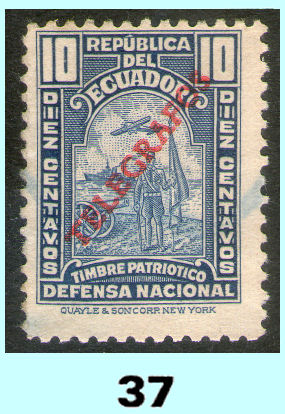
RH108 as in Hiscocks page 103.
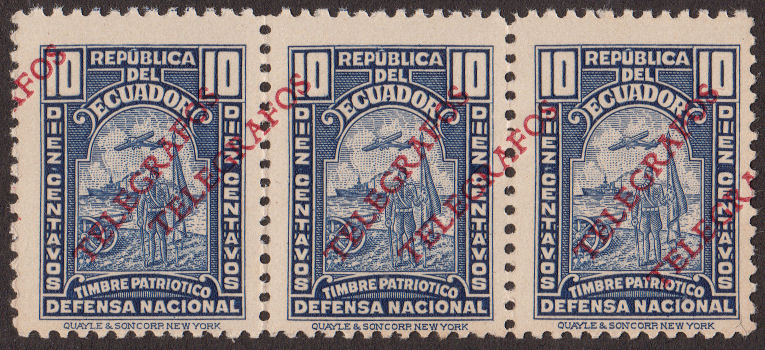
RH108a
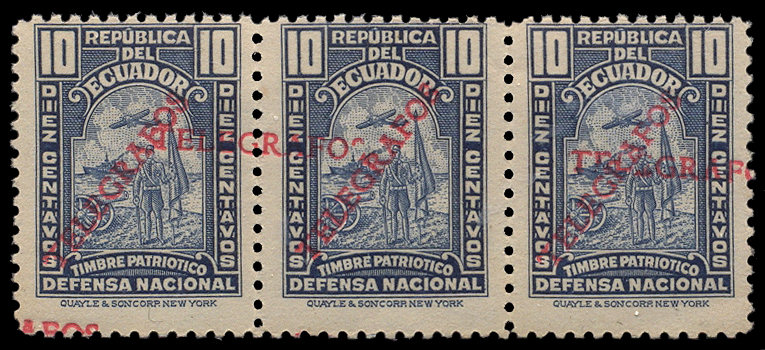
Another example of RH108a - from RL.
| RH # | Hisc. | Type. | Description | Mint | Used |
|---|---|---|---|---|---|
| RH108 | H101 | 37 | 10c deep blue ('TELEGRAFOS' overprint in red) | 3.75 | 3.75 |
| RH108a | H101a | overprint double (in red) | 35.00 | - | |
| RH109 | H102 | 37 | 1s deep violet ('TELEGRAFICOS' overprint in red) | 5.00 | 5.00 |
| RH109a | H102a | overprint double — one red and one black. | 50.00 | - |
My note: The perforations are given as being Perf. 12½ on these, but I am told that a small proportion (perhaps 10%) of the un-overprinted stamps
are actually Perf. 12¼ x 12½. It may be worth checking the perforation on any of these that you may have.
1938-45 Revenue Stamps (sales tax) variously overprinted as indicated below.
White wove paper. No watermark. Perf. 11½. Original control numbers in red.
| RH # | Hisc. | Type. | Description | Mint | Used |
|---|---|---|---|---|---|
| RH110 | H103 | 38 | 10c grey | 6.00 | 4.50 |
| RH110a | H103a | perf. 14 | 15.00 | 10.00 | |
| RH111 | H104 | 39 | 30c on 20c carmine | 6.00 | 4.50 |
| RH112 | H105 | 40 | 30c on 5s red | 6.00 | 4.50 |
| RH112a | H105a | overprint double | 50.00 | - | |
| RH113 | H105A | 40 | 30c on 10s yellow | 8.00 | 5.00 |
| RH114 | H106 | 40 | 30c on 10s bistre | 10.00 | 7.50 |
| RH115 | H106A | 40 | 30c on 20s blue | 10.00 | 7.50 |
| RH115a | - | ultramarine | 15.00 | 10.00 |
1938-45 Tobacco tax stamp surcharged and overprinted in black as below.
White wove paper. No watermark. Rouletted 7 top, bottom and one end.


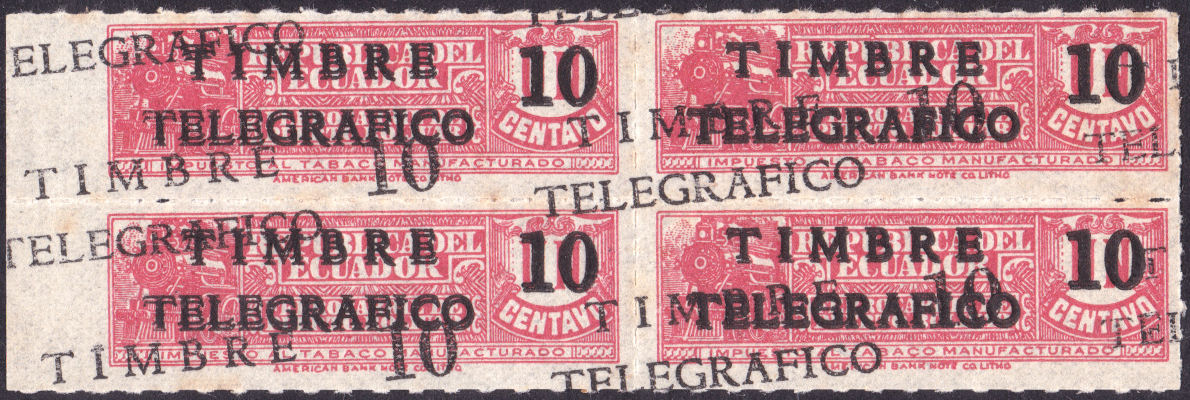
Type 41 of Hiscocks book page 104.
| RH # | Hisc. | Type. | Description | Mint | Used |
|---|---|---|---|---|---|
| RH116 | H107 | 41 | 10c on 1c red | 8.00 | 5.00 |
| RH116a | - | overprint double | 15.00 | 15.00 | |
| RH116b | - | overprint triple | 50.00 | 50.00 |
1939 Engraved by de la Rue on white wove paper. No watermark. Perf. 12½.
| 10c and 30c of Type 42 showing De La Rue imprint. |
| RH # | Hisc. | Type. | Description | Mint | Used |
|---|---|---|---|---|---|
| RH117 | H108 | 42 | 10c carmine-red | 8.00 | 4.00 |
| RH118 | H109 | 42 | 30c yellow-brown | 10.00 | 5.00 |
My note: The defining feature is the de la Rue imprint at the bottom and the value in colour on white.
For a similar but slightly larger 10c, see RH133.
1940-43(?) Revenue stamps ('Moviles') variously overprinted 'TELEGRAFOS' in black unless indicated otherwise. No watermark. Perf. 12.
| Type 43 | Type 44 - RH121 | Type 44 - RH121a Image courtesy of treasurings-jewelry |
Type 45 - RH122 |
Can anyone supply an image of RH120 (red overprint) ?
| Type 46 - RH123, from RL | Type *46A - RH124 |
I have added type *46A as this seems the most appropriate place.
1943 No. H111 (RH120) further overprinted '1943' in black.
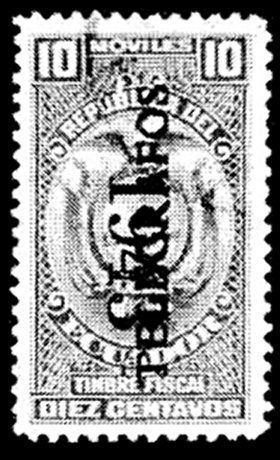 |
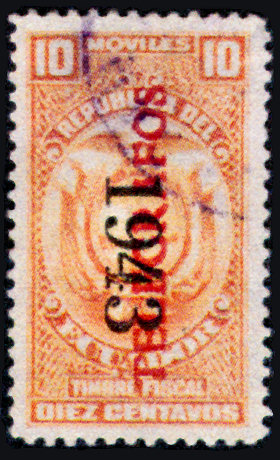 |
Type 47 f rom Hiscocks book page 105, together with one in colour courtesy of John Barefoot, from his number 101.
Clearly this is the exact same stamp. Can anyone supply a better image ?
| RH # | Hisc. | Type. | Description | Mint | Used |
|---|---|---|---|---|---|
| RH128 | H117 | 47 | 10c orange | 20.00 | 10.00 |
Hiscocks added the following note:
| Note. It seems likely that other values were also overprinted '1943'. |
1944(?) Revenue ('Moviles') stamps of 1943 and 1944 overprinted 'TELEGRAFOS' in type 43 in red or black.
White wove paper. No watermark. Perf. 12.
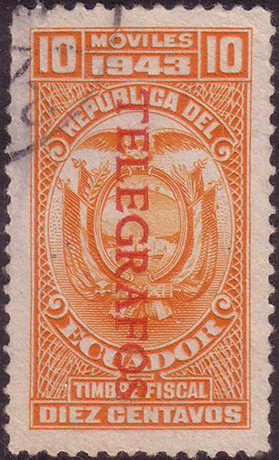
Type 48 - RH129, from RL
| RH # | Hisc. | Type. | Description | Mint | Used |
|---|---|---|---|---|---|
| RH129 | H118 | 48 | 10c orange (1943) (overprint in red) | 15.00 | 10.00 |
| RH130 | H119 | 48 | 30c olive-sepia (1944) (overprint in black) | 15.00 | 10.00 |
Hiscocks added the following note:
| Note. I have a used copy of No. 118 with an April 1945 cds. |
1945 'Patriotic Stamps' of 1937 (as for RH106) overprinted 'TELEGRAFOS' vertically in black, red or blue.
White wove paper. No watermark. Perf. 12½
| Type 49 - RH131a from RL | Type 49 - RH132 | Type 49 - RH132c from RL |
| RH # | Hisc. | Type. | Description | Mint | Used |
|---|---|---|---|---|---|
| RH131 | H120 | 49 | 1s deep violet (overprint in black) | 10.00 | 10.00 |
| RH131a | H120a | overprint in red | 12.00 | 12.00 | |
| RH131b | H120b | overprint in blue | 15.00 | 15.00 | |
| RH132 | H121 | 49 | 2s green (overprint in black) | 12.00 | 12.00 |
| RH132a | H121a | overprint in red | 15.00 | 15.00 | |
| RH132b | H121b | overprint in blue | 18.00 | 18.00 | |
| RH132c | - | new overprint (black) | 25.00 | 25.00 |
Hiscocks added the following note:
| Note. The overprints normally read downwards but they are also found reading upwards. |
1945 Telegraph stamps of type 31 design but die II and Larger, 19½mm x 34½mm (as compared with 18½mm x 33½mm for type 31).
White wove paper. No watermark. Perf. 12½ or 10¾. Columbian Bank Note Company.
| Type 31a (RH102) for REFERENCE | Type 50 10c RH133 | Type 50 10c RH133 | Type 50 10c RH134 |
The two perfinned stamps above and the one below, are courtesy of Niki Oquist.
The perfin is of the Columbian Bank Note Company and may not be in the issued colours. The 30c is certainly a different shade to the used one.
| Type 31 (Die I, RH95) for REFERENCE | Type (51) 1s *RH135 | Type (51) 1s *RH135? | Type 51 1s RH136 |

A strip of RH135 showing the almost complete Specimen perfin of the Columbian Bank Note Company, courtesy of Victor Gugliano (click image for eBay listing).
| RH # | Hisc. | Type. | Description | Mint | Used |
|---|---|---|---|---|---|
| RH133 | H122 | 50 | 10c carmine (shades) (perf. 12½) | 10.00 | 3.00 |
| RH134 | H123 | (51) | 10c sepia (perf. 12½) | 10.00 | 10.00 |
| *RH135 | - | (51) | 30c dark green-blue (perf. 12½) | 10.00 | 10.00 |
| RH136 | H124 | 51 | 1s carmine-vermilion (perf. 10¾) | 15.00 | 10.00 |
For similar, but slightly smaller stamps, see RH69 - RH71 and RH89 - RH107.
* I have added RH135 due to the (rather poor) example shown.
Hiscocks added the following note:
| Note. The date of issue of No. 122 has been reported and Nos. 123 and 124 have been included here because of their similarity of type although they were probably issued at some unknown but later date. |
1945 Postage stamp of 1938 (SG 580) overprinted as shown in black.
White wove paper. No watermark. Perf. 13½ x 12¾.
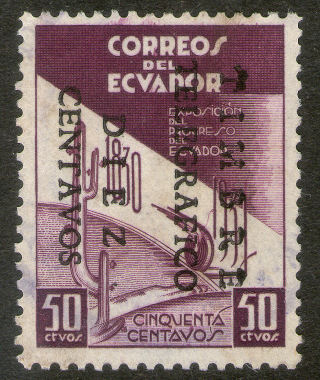
Type 52 (RH137).
The word 'TIMBRE' seems to have been susceptible to damage.
The first letter in particular.
| RH # | Hisc. | Type. | Description | Mint | Used |
|---|---|---|---|---|---|
| RH137 | H125 | 52 | 10c on 50c purple | 10.00 | 5.00 |
1949? Consular stamps overprinted and surcharged in black.
White wove paper. No watermark. Perf. 12.
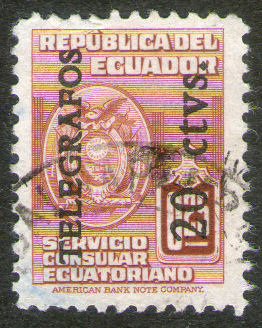
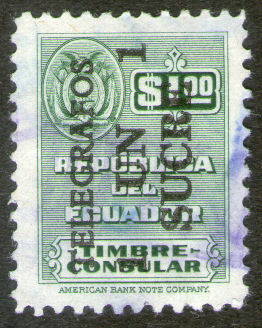
Hiscocks Type 53.
| RH # | Hisc. | Type. | Description | Mint | Used |
|---|---|---|---|---|---|
| RH138 | H126 | 53 | 20c on $0.25 lake-brown (1951?) | 8.00 | 5.00 |
| RH139 | - | (53) | 1s on $1 green (1954?) | 12.00 | 8.00 |
Hiscocks added the following note:
| Note. The suggested date of 1949 is based on the issue of the same stamp overprinted in a very similar style for postal purposes in 1949 (SG 909). |
My note: I am told the series with large emblems, including the $0.25 value was issued (without overprint) in 1945,
and that the series with small emblems including the $1 was issued without overprint in 1951.
It is therefore likely that the $0.25 was overprinted when the series was replaced.
By 1955 a new series by De la Rue was being used ($1 and $2 values), suggesting a date of about 1954 for the $1 being overprinted.
1949? New design of telegraph stamp by American Bank Note Co. (Master die produced 1947)
White wove paper. No watermark. Perf. 12.
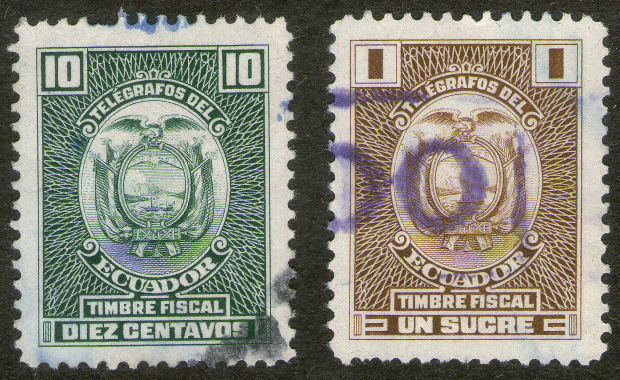
Type 54 (RH140 and RH143).
| RH # | Hisc. | Type. | Description | Mint | Used |
|---|---|---|---|---|---|
| RH140 | H127 | (54) | 10c green | 10.00 | 5.00 |
| RH141 | H128 | 20c ? | - | - | |
| RH142 | H129 | 30c ? | - | - | |
| RH143 | H130 | 54 | 1s olive-sepia | 25.00 | 5.00 |
| RH144 | H131 | 2s ? | - | - | |
| RH145 | H132 | 5s ? | - | - |
Hiscocks added the following 2 notes:
| Note 1. The date of 1949 is suggested because other, fiscal stamps of similar type appeared in the 1949-51 period. |
| Note 2. It seems probable that the full normal series was produced (probably by the American Bank Note Co.) but I have only seen the 1s value. |
My Note: The 10c is now known, and an 80c brown was later overprinted 1 Sucre (see RH160),
but strangely it is not known without the overprint.
For RH143 overprinted '1953' see RH149.
It is highly likely that other values and/or overprints exist. Scans would be very welcome.
1950 New design of telegraph stamp. Lithographed by the Institut de Gravure, Paris.
White wove paper. No watermark. Perf. 13.
| Type 55 30c RH146 | Type 55 2s RH147 | Type 55 5s RH148 |
Hiscocks Type 55, Imprint of Institut de Gravure, Paris
| RH # | Hisc. | Type. | Description | Mint | Used |
|---|---|---|---|---|---|
| RH146 | H135 | 55 | 30c brown (10,000,000) | 10.00 | 5.00 |
| RH147 | H137 | 55 | 2s bright carmine (1,000,000) | 18.00 | 10.00 |
| RH148 | H138 | 55 | 5s deep turquoise-blue (500,000) | 20.00 | 12.50 |
Niki Oquist has provided some images of proofs / colour trials. Shown complete (half size) and just centre at 600dpi.
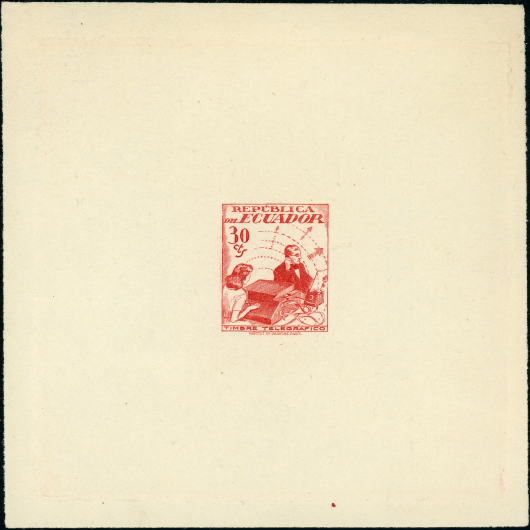
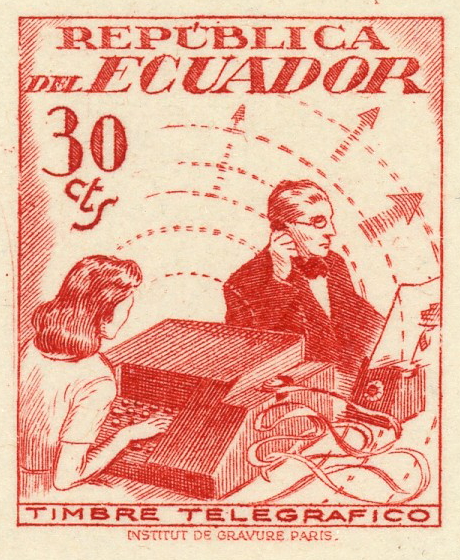
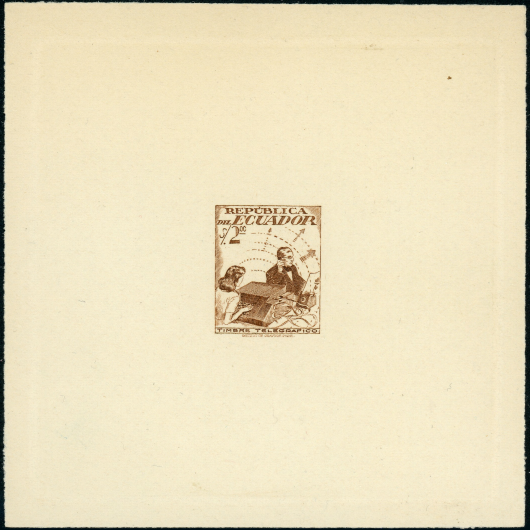
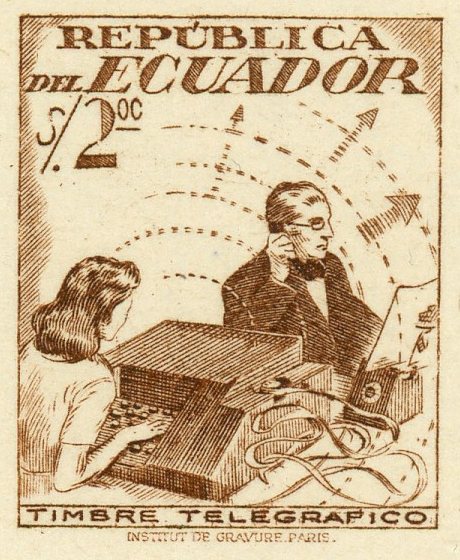
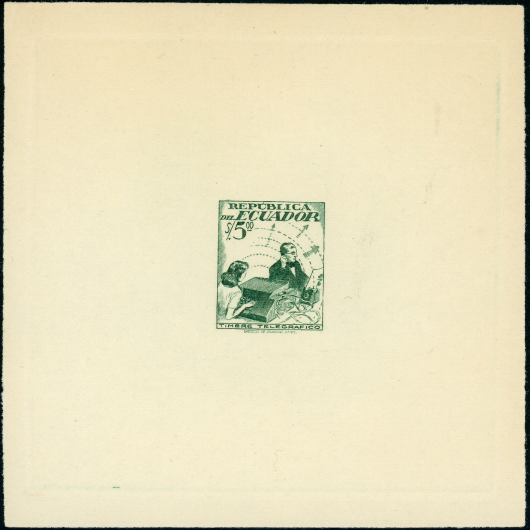
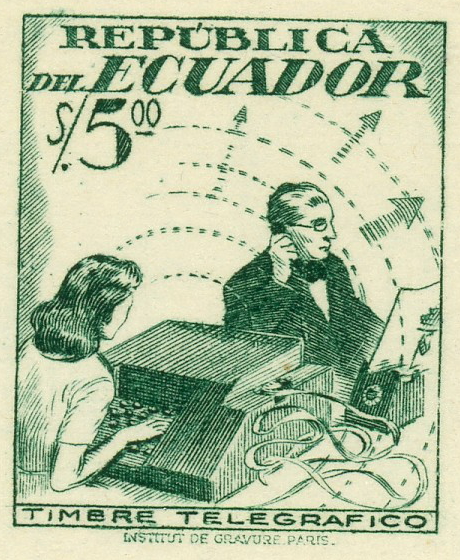
As can be seen, these are not the same as the issued colours.
Hiscocks added the following 2 notes:
| Note 1. Again the existence of the 10c and 20c and 1s values is assumed but they have not been reported. |
| Note 2. The suggested date is based on the use of these printers by the Ecuador Government between 1948 and 1954, and the likely elapse of some years after the issue of those(?) of type 54. The printer went out of business around 1960 and the records are not available. |
I deleted the 10c, 20c and 1s value and corrected the date due to information from K. Zwart.
1953 Type 54 overprinted '1953'
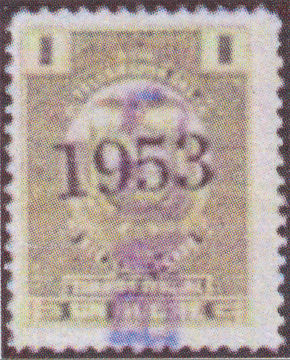
Image courtesy of John Barefoot.
| RH # | Hisc. | Type. | Description | Mint | Used |
|---|---|---|---|---|---|
| RH149 | - | 54 + | 1s olive-sepia | 25.00 | 5.00 |
1954 As above overprinted 'Pro-Tourismo / 1954' and surcharged.
White wove paper. No watermark. Perf 13.
The Scott Catalogue lists this as a 'Postal Tax Stamp' RA70), so presumably it was not used for telegraphic purposes.
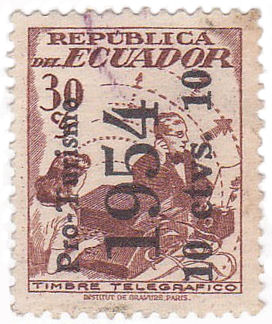 |
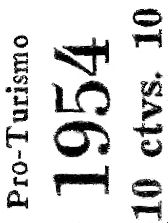 |
| New overprint type 56, image courtesy of stampsergej on ebay. | |
There is another overprint of "ESCOLAR / 20 / Centavos" sideways on the same stamp that Scott lists similarly as RA66.
I have also seen "Educatión / Pública" on the 1s magenta.
1954 As last, but Photogravure by the Heraclio Fournier, Vitoria.
White wove paper. No watermark. Perf. 11½.
| Type (55A) 10c RH150 - from RL | Type (55A) 20c RH151 | Type (55A) 2s RH152 | Type (55A) 5s RH153 |
Type 55A. Imprint of Heraclio Fournier, Vitoria.
| RH # | Hisc. | Type. | Description | Mint | Used |
|---|---|---|---|---|---|
| RH150 | - | 55A | 10c orange-brown (1,000,000) | 8.00 | 5.00 |
| RH151 | - | 55A | 20c green (1,000,000) | 8.00 | 4.50 |
| RH152 | - | 55A | 2s deep blue-green (500,000) | 18.00 | 10.00 |
| RH153 | - | 55A | 5s brown (500,000) | 20.00 | 12.50 |
I deleted the 30c and 1s value, re-ordered and corrected the date due to information from K. Zwart.
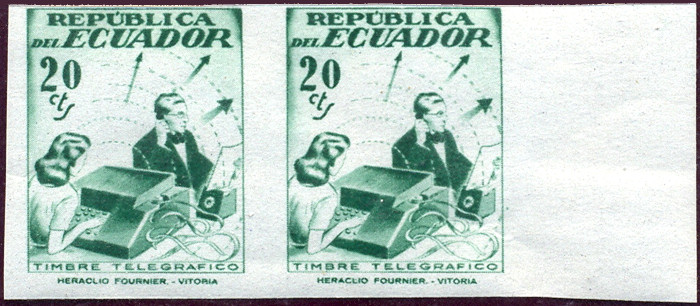
An proof of the 20c - from RL.
1956? Similar but slightly larger version. Lithographed(?) by the Thomas De La Rue & Co. Ltd..
White wove paper. No watermark. Perf. 14 x 14½.
| Type (55B) 10c RH154 | Type (55B) 20c RH155 | Type (55B) 30c RH156 |
| Type (55B) 1s RH157 - from RL | Type (55B) 2s RH158 - from RL | Type (55B) 5s RH159 - from RL |
Type 55B. Imprint of Thomas De La Rue & Co.Ltd.
| RH # | Hisc. | Type. | Description | Mint | Used |
|---|---|---|---|---|---|
| RH154 | - | 55B | 10c green (5,000,000) | 6.00 | 4.00 |
| RH155 | - | 55B | 20c bright pale blue (5,000,000) | 8.00 | 4.50 |
| RH156 | - | 55B | 30c brown (5,000,000) | 10.00 | 5.00 |
| RH157 | - | 55B | 1s magenta (10,000,000) | 15.00 | 8.00 |
| RH158 | - | 55B | 2s orange (2,000,000) | 18.00 | 10.00 |
| RH159 | - | 55B | 5s scarlet (2,000,000) | 20.00 | 12.50 |
An example of the 10c has been seen used postally on a cover dated 14 November 1958
1954? Moviles revenue stamp (similar to type 54) overprinted 'TELEGRAFOS' and surcharged.
White wove paper. No watermark. Perf. 12 x 11¾
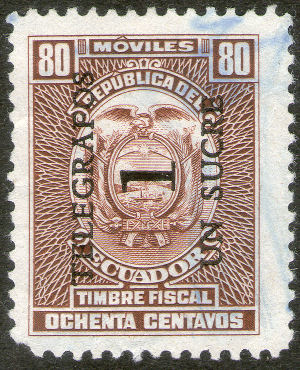
Not listed by Hiscocks, I will call this Type 56.
| RH # | Hisc. | Type. | Description | Mint | Used |
|---|---|---|---|---|---|
| RH160 | - | 56 | 1s on 80c brown | 15.00 | 8.00 |
Hiscocks added the following General Note:
| General Note. It is not known when or even whether the use of telegraph stamps ceased in Ecuador. Many of the dates suggested above will be wrong and no doubt there are other telegraph stamps to be reported. Nos. 139-149 have been left unused to accommodate additions. Any further information would be welcomed. |
Official Telegraph Stamps.
1895 Fiscal stamps of 1887-1888 overprinted 'Telegrafos / SERVISIO OFICIAL' and surcharged in red or blue (reading up or down).
White wove paper. No watermark. Perf. 12.
| Type (61 on 60) 1c RH161 - from RL | Type (61 on 60) 2c RH162 | Type 61 from page 107 |
| RH # | Hisc. | Type. | Description | Mint | Used |
|---|---|---|---|---|---|
| RH161 | H150 | 60, 61 | 10c on 1c deep blue-green overprinted in red. | 20.00 | 20.00 |
| RH162 | H151 | 60, 61 | 20c on 2c carmine overprinted in blue | 20.00 | 20.00 |
Hiscocks added the following note:
| Note. Reading up or down. |
1897 As above but overprinted as indicated in black or dark blue.
| Type (63 on 62) 1c RH163 | Type (63 on 62) 2c RH165 | Type 63 from page 108 |
| RH # | Hisc. | Type. | Description | Mint | Used |
|---|---|---|---|---|---|
| RH163 | H152 | 62, 63 | 1c deep blue-green overprinted in black | 5.00 | 5.00 |
| RH164 | H153 | 62, 63 | 1c deep blue-green overprinted in blue | 15.00 | 15.00 |
| RH165 | H154 | 62, 63 | 2c carmine overprinted in black | 15.00 | 15.00 |
| RH166 | H155 | 62, 63 | 2c carmine overprinted in blue | 25.00 | 25.00 |
Hiscocks added the following note:
| Note. Normally reading upwards. |
My Note. According to the Ecuador Philatelic Study Group, there is some doubt about the authenticity of these stamps.
Used copies do not have very convincing cancels and for official telegrams, "it was expressly established that they should not pay any value".
The 1895 issue does appear in the price list of Agustín Albán, published in 1898, though described as being 1896, so those at least do date from that period.
I still need about a dozen images to complete this.
If anyone can provide scans to help, I am happy to give appropriate credit.
Tax Stamps.
I am not sure if these were obligatory or not, but a lot of stamps are listed as being for taxes of various types, and whilst most are explicitly
marked as being postal, some are suggestive as being required for telegraph use also.
I would really like to hear from anyone that
knows for certain.
| 1934 2c RHT1 | 1934 20c RHT2 - from RL | 1934 2c RHT3 | 1934 2c RHT4 |
| 1935 20c RHT5 - from RL | 1936 20c RHT6 - from RL | 1936 20c RHT6a Overprint doubled - from RL |
| 1938 20c RHT7 - from RL |
| 1940 5c RHT8 | 1940 20c RHT9 - from RL |
| 1942 20c RHT10 - from RL | 1942 20c RHT10a overprint doubled - from RL |
| 1940? 5c RHT11 - from RL | 1942? 5c RHT12 - from RL |
Tentative listing.
| RH # | Hisc. | Type. | Description | Mint | Used |
|---|---|---|---|---|---|
| RHT1 | - | 1 | 2c (1934) green | 0.15 | 0.15 |
| RHT2 | - | 2 | 20c (1934) ultramarine and yellow | 0.40 | 0.25 |
| RHT3 | - | 3 | 2c on 10c (1934) brown (red, black) | 0.25 | 0.20 |
| RHT4 | - | 3 | 2c on 10c (1934) brown (blue, red) | 0.25 | 0.20 |
| RHT5 | - | 4 | 20c (1935) claret | 0.35 | 0.30 |
| RHT6 | - | 5 | 20c (1936) ultramarine and yellow | 0.40 | 0.25 |
| RHT6a | - | double overprint | - | - | |
| RHT7 | - | 6 | 20c on 70c (1938) black | 0.55 | 0.30 |
| RHT8 | - | 7 | 5c on 1c (1940) red | 0.50 | 0.20 |
| RHT9 | - | 8 | 20c on 50c (1940) multicoloured | 0.55 | 0.30 |
| RHT10 | - | 9 | 20c on 50c (1942) multicoloured | 0.55 | 0.30 |
| RHT10a | - | double overprint | - | - | |
| RHT11 | - | 10 | 5c red-brown | 0.35 | 0.20 |
| RHT12 | - | 10 | 5c green | 0.35 | 0.20 |
Prepaid Telegraph Forms.
These were introduced at the beginning of 1900 due to shortcomings of the telegraph staff in following their procedures and
a perceived loss of revenue because of it. The first type was a similar design (I am told) to that used on postal stationery at the time.
Type F1.
Type F2.
An Executive Decree of 1914, described the requirements to be met by the telegraphic forms that were issued for the biennium 1915-1916,
and that had to circulate from January 1, 1915. The Decree, subscribed by President Leonidas Plaza Gutiérrez, was published in the Official
Gazette 683 of December 16, 1914. According to that document, the formulas, like all the valued species of that time, were valid for two years.
In the case of telegraphs, it was arranged to print four types, with as many face values, identified as series, from A to D, indicating the colour
of each, according to the following table:
It is thought that the colours were changed every two years. Examples of the ones listed above are not known, but other colours are.
The implication is that only a small fraction of them still exist. This design is similar to the (first?) telegram seals of circa 1914 Ecuador.
There was also space for additional telegraph stamps. The following images are from K. Zwart and the Ecuador Philatelic Study Group:
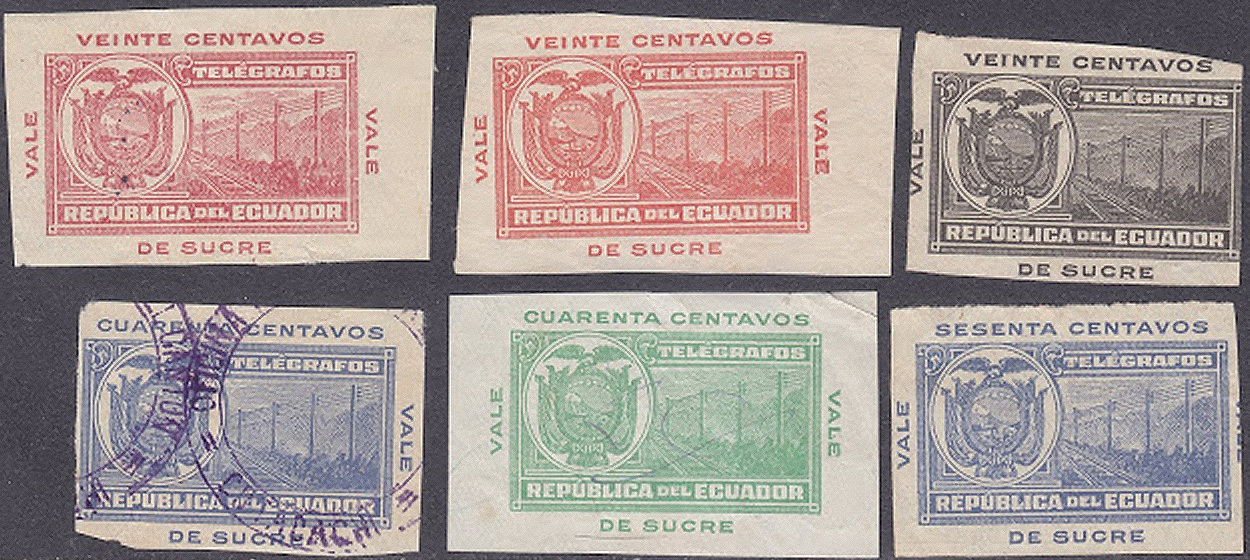
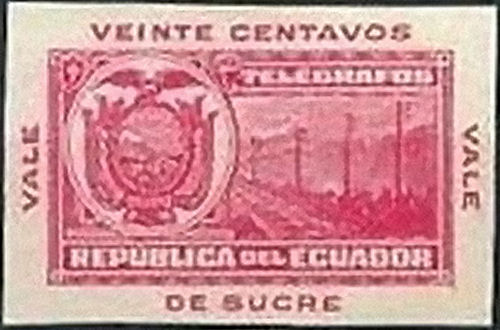
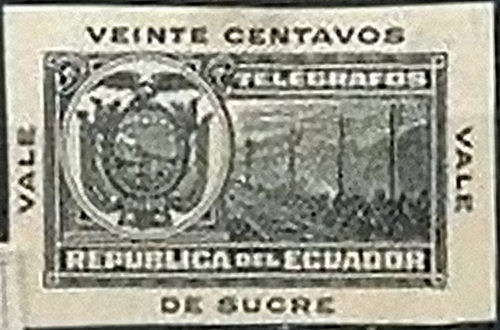
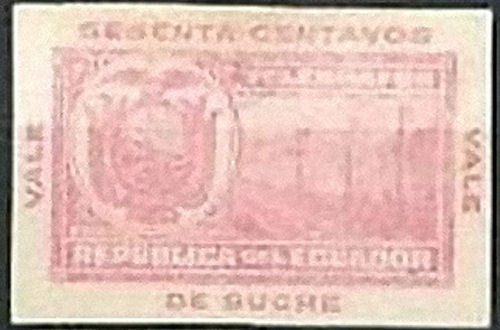


The only form I have seen was dated 1925 and was in an article entitled 'Ecuador: A Prepaid Telegraph Form' by Brian Moorhouse.
The article was published in 'The Mainsheet' in February 2000. His description is as follows:
The implication is that the impressed stamp was printed in the same colour as the rest of the form.
My thanks to K. Zwart for providing this information and images above.
The majority of these cut-outs appear to be from unused (or perhaps spoiled) forms, implying that the form had been mutilated for no good reason.
If you have a complete form, it may be unique. Please don't cut it up!
I have since found out that this article is referenced in an article in the Medio Real magazine of the
Ecuador Philatelic Study Group.
Which makes available colour images of this form and other images shown below:
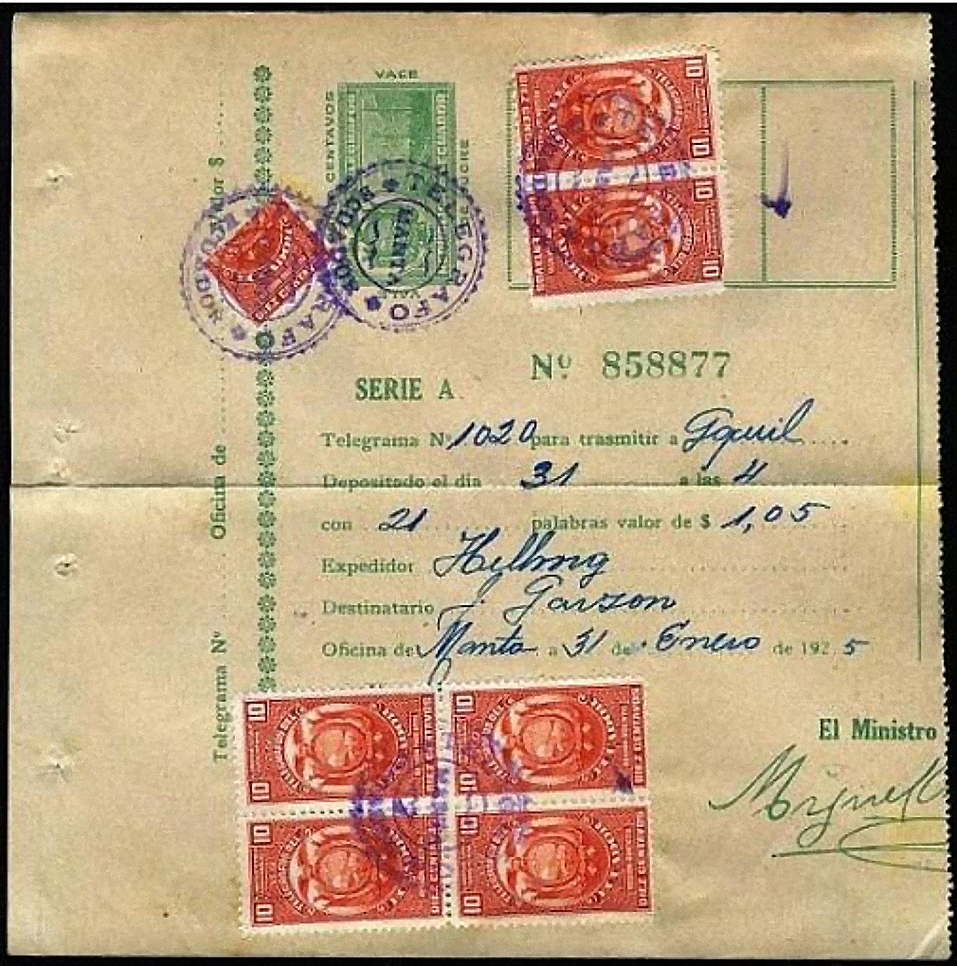
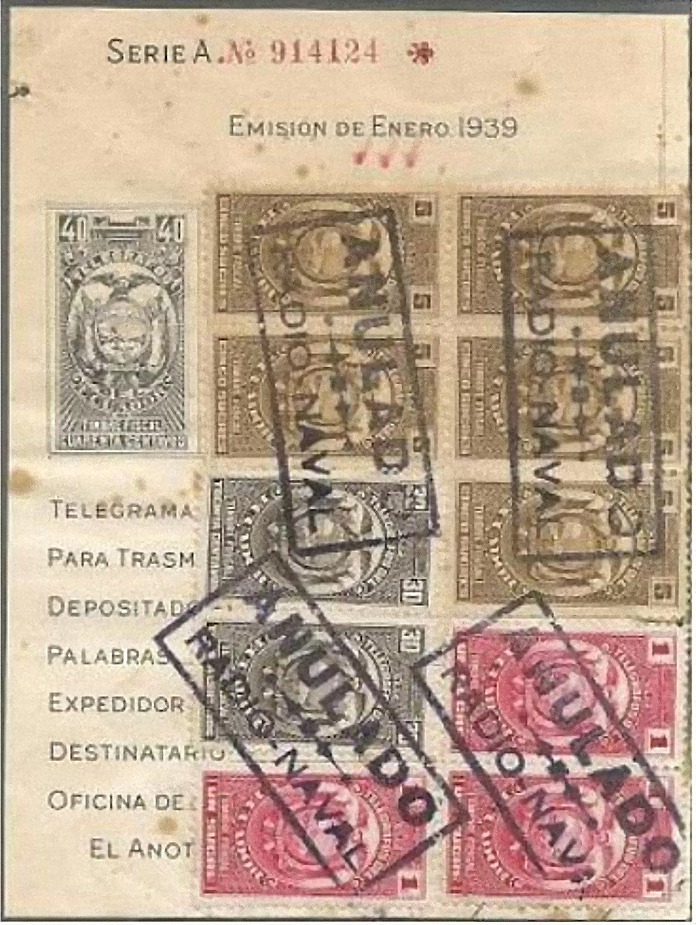
Type F3.
The Ecuador PSG also show a piece of a later form issued January 1939 with a new 40c type of imprinted stamp.
Again, there may well have been other values and colours used and further images and information would be welcome.
There is a very interesting cancel used on this last piece that I have not seen elsewhere.
Known types:
| RH # | Hisc. | Type. | Description | Mint | Used | Complete Form |
|---|---|---|---|---|---|---|
| RHF1 | - | F1 | 20c (Veinte) Black | - | - | - |
| RHF2 | - | F1 | 30c (Treinta) Red | - | - | - |
| RHF3 | - | F2 | 20c (Veinte) Black | - | - | - |
| RHF4 | - | F2 | 20c (Veinte) Carmine | - | - | - |
| RHF5 | - | F2 | 20c (Veinte) Rose Red | - | - | - |
| RHF6 | - | F2 | 40c (Cuarenta) Light Green | - | - | - |
| RHF7 | - | F2 | 40c (Cuarenta) Blue | - | - | - |
| RHF8 | - | F2 | 60c (Sesenta) Dark Blue | - | - | - |
| RHF9 | - | F2 | 60c (Sesenta) Rose Red | - | - | - |
| RHF10 | - | F3 | 40c (Cuarenta) Black | - | - | - |
Can anyone provide further scans, of these?
I also have a page devoted to the Telegram Seals of Ecuador.
